#oldest inhabited house in Britain
Text
Events 5.9
328 – Athanasius is elected Patriarch of Alexandria.
1009 – Lombard Revolt: Lombard forces led by Melus revolt in Bari against the Byzantine Catepanate of Italy.
1386 – England and Portugal formally ratify their alliance with the signing of the Treaty of Windsor, making it the oldest diplomatic alliance in the world which is still in force.
1450 – 'Abd al-Latif (Timurid monarch) is assassinated.
1540 – Hernando de Alarcón sets sail on an expedition to the Gulf of California.
1662 – The figure who later became Mr. Punch makes his first recorded appearance in England.
1671 – Thomas Blood, disguised as a clergyman, attempts to steal England's Crown Jewels from the Tower of London.
1726 – Five men arrested during a raid on Mother Clap's molly house in London are executed at Tyburn.
1864 – Second Schleswig War: The Danish navy defeats the Austrian and Prussian fleets in the Battle of Heligoland.
1865 – American Civil War: Nathan Bedford Forrest surrenders his forces at Gainesville, Alabama.
1865 – American Civil War: President Andrew Johnson issues a proclamation ending belligerent rights of the rebels and enjoining foreign nations to intern or expel Confederate ships.
1873 – Der Krach: The Vienna stock exchange crash heralds the Long Depression.
1877 – Mihail Kogălniceanu reads, in the Chamber of Deputies, the Declaration of Independence of Romania. The date will become recognised as the Independence Day of Romania.
1901 – Australia opens its first national parliament in Melbourne.
1915 – World War I: Second Battle of Artois between German and French forces.
1918 – World War I: Germany repels Britain's second attempt to blockade the port of Ostend, Belgium.
1920 – Polish–Soviet War: The Polish army under General Edward Rydz-Śmigły celebrates its capture of Kiev with a victory parade on Khreshchatyk.
1926 – Admiral Richard E. Byrd and Floyd Bennett claim to have flown over the North Pole (later discovery of Byrd's diary appears to cast some doubt on the claim.)
1927 – The Old Parliament House, Canberra, Australia, officially opens.
1936 – Italy formally annexes Ethiopia after taking the capital Addis Ababa on May 5.
1941 – World War II: The German submarine U-110 is captured by the Royal Navy. On board is the latest Enigma machine which Allied cryptographers later use to break coded German messages.
1942 – The Holocaust in Ukraine: The SS executes 588 Jewish residents of the Podolian town of Zinkiv (Khmelnytska oblast. The Zoludek Ghetto (in Belarus) is destroyed and all its inhabitants executed or deported.
1946 – King Victor Emmanuel III of Italy abdicates and is succeeded by Umberto II.
1948 – Czechoslovakia's Ninth-of-May Constitution comes into effect.
1950 – Robert Schuman presents the "Schuman Declaration", considered by some to be the beginning of the creation of what is now the European Union.
1955 – Cold War: West Germany joins NATO.
1960 – The Food and Drug Administration announces it will approve birth control as an additional indication for Searle's Enovid, making Enovid the world's first approved oral contraceptive pill.
1969 – Carlos Lamarca leads the first urban guerrilla action against the military dictatorship of Brazil in São Paulo, by robbing two banks.
1974 – Watergate scandal: The United States House Committee on the Judiciary opens formal and public impeachment hearings against President Richard Nixon.
1979 – Iranian Jewish businessman Habib Elghanian is executed by firing squad in Tehran, prompting the mass exodus of the once 100,000-strong Jewish community of Iran.
1980 – In Florida, United States, Liberian freighter MV Summit Venture collides with the Sunshine Skyway Bridge over Tampa Bay, making a 1,400-ft. section of the southbound span collapse. Thirty-five people in six cars and a Greyhound bus fall 150 ft. into the water and die.
1980 – In Norco, California, United States, five masked gunmen hold up a Security Pacific bank, leading to a violent shoot-out and one of the largest pursuits in California history. Two of the gunmen and one police officer are killed and thirty-three police and civilian vehicles are destroyed in the chase.
1987 – LOT Flight 5055 Tadeusz Kościuszko crashes after takeoff in Warsaw, Poland, killing all 183 people on board.
1988 – New Parliament House, Canberra officially opens.
1992 – Armenian forces capture Shusha, marking a major turning point in the First Nagorno-Karabakh War.
1992 – Westray Mine disaster kills 26 workers in Nova Scotia, Canada.
2001 – In Ghana, 129 football fans die in what became known as the Accra Sports Stadium disaster. The deaths are caused by a stampede (caused by the firing of tear gas by police personnel at the stadium) that followed a controversial decision by the referee.
2002 – The 38-day stand-off in the Church of the Nativity in Bethlehem comes to an end when the Palestinians inside agree to have 13 suspected terrorists among them deported to several different countries.
2018 – The historic defeat for Barisan Nasional, the governing coalition of Malaysia since the country's independence in 1957 in 2018 Malaysian general election.
2020 – The COVID-19 recession causes the U.S. unemployment rate to hit 14.9 percent, its worst rate since the Great Depression.
2022 – Russo-Ukrainian War: United States President Joe Biden signs the 2022 Lend-Lease Act into law, a rebooted World War II-era policy expediting American equipment to Ukraine and other Eastern European countries.
2 notes
·
View notes
Text
Are There Any Thatched Roofs in Australia?
UK citizens might think thatched roofs are quintessentially British but, of course, we’d be wrong. Buildings with thatched roofs have been around for millennia and are part of the history and culture of many communities.
But are there any thatched roofs in Australia? Yes, there are thatched roofs in Australia. Indigenous Australians used thatch to weatherproof their properties by using suitable materials that were to hand. These communities used different methods and different materials to thatchers in Britain and around the world.
But rural people the world over thatched their homes using what was locally available because it was cheap and easy to replace.
But we do have to put aside the idea that thatched roofs in Australia are similar to thatched cottages that are part of the chocolate-box idea of British rural life.
They are not. So to learn more about the types of thatched roofs found in Australia in the past and present, we need to delve deeper into the use of thatch ‘down under’.
Can You Have a Thatched Roof in Australia?
You can have thatched roofs anywhere. And you can certainly expect to see thatched roofs in Australia. They are rarer in Aus than in other countries, though.
And as with most areas of the world, you are quite likely to see thatch used on rural or heritage dwellings.
In modern or urban settlements you are more likely to find thatched roofs used in feature buildings, such as bars or pool houses, but these are often more about aesthetics than practicality.
Modern buildings tend to use roofing materials that are fire-resistant and scientifically balanced for both insulation and ventilation. Using thatch on modern architecture might not only look strange but would be difficult to maintain on certain buildings and expensive to insure.
Not only this but unlike modern roofing, thatching requires niche tradesmen whose skills are rightly expensive.
Thatch is also costly to maintain and, depending on the climate and weather conditions of the Australian territory you’re in, thatch might even be impractical.
To see why thatch is more rare in Australia than it is elsewhere we’re going to have to look to the country’s past, culture and climate.
Why is Thatch in Australia Quite Rare?
Let’s go back to the use of thatch by the inhabitants of various territories of mainland Australia before colonisation. Because Australia is continental in its scale, the indigenous people from various areas used different types of thatch for different purposes.
Those people in many areas of the country which is considered ‘the oldest, flattest, and driest inhabited continent, with the least fertile soil’ used thatch for shade more often than shelter from wind and rain.
But because the peoples of Australia were distinct communities, their methods of dwelling construction and thatching were designed to suit whatever their environment happened to dictate.
What Were the Traditional Thatched Dwellings of Australia?
This is especially true of the Gunyah, Humpy, or Wurleys which are domed or piqued structures that use whatever vegetation is close at hand. This might be palm, branches or scrub, or leaves and grasses.
Whether these can be considered to have a thatched roof is up for debate because the entire structure is constructed from natural materials. So it might be better to consider these domed buildings as entirely thatched.
The problem with pinpointing the breadth of thatched roof design and construction across the whole country is immensely difficult.
This is partly because the buildings are semi-permanent and made of natural materials that rot away. And partly because until recently, indigenous traditions weren’t recorded or investigated with much rigour.
How Did Thatched Roofs Change in Australia After Colonialisation?
The kind of thatch roofs that people from the UK are familiar with were constructed in certain territories of Australia but this style is considered ‘Colonial Thatch’.
It was used by the first colony of settlers to Australia and blended the thatching techniques of the UK and Europe with the materials used by the indigenous population.
As British colonisation of Australia progressed, buildings became more permeant and took on similar shapes to single-story rural dwellings in Britain and Ireland.
This included the thatched roof style that is common in the British Isles, including a timber frame, pitched roof and thatch tied to joists and topped by the ridge for added weatherproofing.
Arable farming became established in certain colonised areas and the wheat production added to the availability of this as an additional thatching material.
And because many indigenous people were forced into reservations or enclosures, many of their traditional dwelling types were lost to colonialisation.
Are Thatched Roofs Used in Modern Australian Properties?
The subsequent population boom in Australia since the post-war years has required a rapid expansion in housing. And because traditional thatched roofs require constant maintenance and are prone to animal damage, rot easily and are highly inflammable it’s easy to understand why their popularity had waned.
The most likely place you will find a thatched roof in Australia is for a garden or occasional structure of some kind. Pergolas, outdoor bars, or garden rooms are popular choices to add a thatched roof to.
And many holiday resorts like to amplify the ambience of their buildings by adding thatch to create an exotic paradise.
But just because thatched roofs have not been a popular choice for domestic housing in Australia in the last century, it doesn’t mean they are not an option for the right type of home.
Many people are looking at greener building choices and ways of incorporating sustainable materials into house design. And that’s why thatch is finding a slight resurgence in popularity.
The lifespan for thatch in Brisbane and Melbourne is roughly 50 years which is standard for most thatched roofs. And thatch acts as a natural insulator which can keep properties cooler in summer. It’s a greener choice than running air conditioning throughout the day.
And there’s no denying that factoring in a thatched roof into the design of a modern property would certainly have the wow factor.
And adding a thatched roof would also act as a nod to the traditions of the indigenous people of Australia and link the present with the past.
source https://villageandcottage.com/thatched-roofs/are-there-any-thatched-roofs-in-australia/
0 notes
Text
93 English words that derive from place names
This is not a comprehensive list and focuses only on Europe and Mediterranean countries. It excludes cheese and wines.
All definitions taken from Wiktionary, excluding definitions that refer to nationalities.
academia (the Academy, Greece, an Athenian gymnasium where Plato taught): the scientific and cultural community engaged in higher education and research, taken as a whole.
afro (Africa): hairstyle characterized by tightly curled locks and a rounded shape.
alpine (the Alps): of, relating to, or inhabiting mountains, especially above the timberline.
Alsatian (Alsace, France): a German shepherd dog.
angora (Ankara, Turkey): an angora cat; a goat of a domesticated breed that produces mohair; a rabbit belonging to the Angora rabbit breed, one of the oldest domestic breeds of rabbits in the world, raised chiefly in Europe for its silky and long hair (a subspecies of the European rabbit, Oryctolagus cuniculus).
Armageddon (Tel Megiddo, Israel): (Christianity, Islam) Mount Megiddo, the site of a prophesied final battle between the forces of good and evil; (by extension) the battle itself.
Armagnac (Armagnac, France): a brandy made in the region of Armagnac.
attic (Attica, Greece): the space, often unfinished and with sloped walls, directly below the roof in the uppermost part of a house or other building, generally used for storage or habitation.
badminton (Badminton House, an estate in Gloucestershire, United Kingdom): a racquet sport played indoors on a court by two opposing players (singles) or two opposing pairs of players (doubles), in which a shuttlecock is volleyed over a net and the competitions are presided by an umpire in British English and a referee in American English.
balaclava (Balaklava, Ukraine): a type of warm headgear covering the neck, head, and often part of the face, with apertures left as necessary, often made out of wool.
bayonet (Bayonne, France): a pointed instrument of the dagger kind fitted on the muzzle of a musket or rifle, so as to give the soldier increased means of offense and defense. Originally, the bayonet was made with a handle, which needed to be fitted into the bore of the musket after the soldier had fired.
bedlam (Bedlam, United Kingdom, alternative name of the English lunatic asylum, Bethlem Royal Hospital): a place or situation of chaotic uproar, and where confusion prevails.
beyond the pale (The Pale, Ireland): of a person or their behaviour: outside the bounds of what is acceptable, or regarded as good judgment, morality, etc.
Bible (Byblos, Lebanon): the main religious text in Christianity.
bohemian (Bohemia, Czech Republic): an unconventional or nonconformist artist or writer.
bolognese (Bologna, Italy): an Italian sauce made of ground meat and tomato.
bugger (Bulgaria): a heretic; (Britain law) someone who commits buggery; a sodomite.
Byzantine (Byzantium [present-day Istanbul], Turkey): overly complex or intricate.
cardigan (Cardigan, United Kingdom): a type of sweater or jumper that fastens up the front with buttons or a zipper, usually machine- or hand-knitted from wool.
Caucasian (Caucasus): of a racial classification pertaining to people having certain phenotypical features such as straight, curly, or wavy hair and very light to brown pigmented skin, and originating from Europe, parts of Northern Africa and Central, South, and Western Asia.
chartreuse (Chartreuse Mountains, France): a yellow or green liqueur made by Carthusian monks; a greenish-yellow colour.
coach (Kocs, Hungary): a wheeled vehicle, generally drawn by horse power.
cognac (Cognac, France): a brandy distilled from white wine in the region around Cognac in France.
cologne (Cologne, Germany): a type of perfume consisting of 2-5% essential oils, 70-90% alcohol and water.
copper (Cyprus): a reddish-brown, malleable, ductile metallic element with high electrical and thermal conductivity, symbol Cu, and atomic number 29.
cordovan (Córdoba, Spain): a leather from Córdoba originally of tanned goatskin later of horsehide.
cravat (Croatia): a wide fabric band worn as a necktie by men having long ends hanging in front.
Dalmatian (Dalmatia, Croatia): one of a breed of dog with a short, white coat with dark spots.
damask (Damascus, Syria): an ornate silk fabric originating from Damascus.
Danish (Denmark): a sweet and flaky yeast-raised roll made from a dough using butter or margarine and filled with remonce (butter and sugar) or custard.
denim (“de Nîmes” [from Nîmes], France): textile often made of cotton with a distinct diagonal pattern.
derby (from the Epsom Derby horse race, in Derbyshire, United Kingdom): any of several annual horse races.
dollar (Joachimstal [present-day Jáchymov], Czech Republic): official designation for currency in some parts of the world, including Canada, the United States, Australia, New Zealand, Hong Kong, and elsewhere. Its symbol is $.
duffel bag (Duffel, Belgium): a large, cylindrical, duffel cloth bag used to carry personal gear, especially by soldiers.
fez (Fez, Morocco): a felt hat in the shape of a truncated cone, having a flat top with a tassel attached.
frankfurter (Frankfurt, Germany): a moist sausage of soft, even texture and flavor, often made from mechanically recovered meat or meat slurry.
frankly (the Franks, France and Germany): in a frank or candid manner, especially in a way that may seem too open, excessively honest, or slightly blunt.
geyser (The Great Geysir, Iceland): a boiling natural spring which throws forth at frequent intervals jets of water, mud etc., driven up by the expansive power of steam.
jeans (Genoa, Italy): a pair of trousers made from denim cotton.
jersey (Jersey, United Kingdom): a garment knitted from wool, worn over the upper body.
hamburger (Hamburg, Germany): a hot sandwich consisting of a patty of cooked ground beef or a meat substitute, in a sliced bun, sometimes also containing salad vegetables, condiments, or both.
hollandaise (Holland, the Netherlands): an emulsion of butter and lemon juice using egg yolks as the emulsifying agent, used in French cooking.
italics (Italy): letters in an italic typeface.
laconic (Laconia, Greece): using as few words as possible; pithy and concise.
lesbian (Lesbos, Greece): (of a woman) homosexual, gay; preferring mostly or exclusively women as romantic or sexual partners.
limerick (Limerick, Ireland): a humorous, often bawdy verse of five anapestic lines, with the rhyme scheme aabba, and typically having a 8–8–5–5–8 cadence.
limousine (Limousin, France): an automobile body with seats and permanent top like a coupe, and with the top projecting over the driver and a projecting front.
magenta (Magenta, Italy): a vibrant light purple, purplish-red, reddish-purple, or pinkish purple color obtained by mixing red and blue light (thus a secondary color), but primary in the CMYK color system used in printing.
magnet (Magnesia, Greece): a piece of material that attracts some metals by magnetism.
Maltese (Malta): a small breed of dog with a long silky coat.
marathon (Marathon, Greece): a 42.195 kilometer (26 mile 385 yard) road race.
mausoleum (Mausolus, ruler of Caria, Turkey): a large stately tomb or a building housing such a tomb or several tombs.
mayonnaise (Maó, Spain): a dressing made from vegetable oil, raw egg yolks and seasoning, used on salads, with french fries, in sandwiches etc.
meander (Büyük Menderes River, Turkey): one of the turns of a winding, crooked, or involved course.
muscovite (Moscow, Russia): a pale brown mineral of the mica group, being a basic potassium aluminosilicate with the chemical formula KAl2(Si3Al)O10(OH,F)2; used as an electrical insulator etc.
muslin (Mosul, Iraq): any of several varieties of thin cotton cloth.
Neanderthal (Neandertal, Germany): old-fashioned, opposed to change.
Nokia (Nokia, Finland): a phone produced by the Nokia company.
Olympics (Olympia, Greece): an international multi-sport event (inspired by the ancient festival) taking place every fourth year
ottoman (Turkey): an upholstered sofa, without arms or a back, sometimes with a compartment for storing linen etc.
paisley (Paisley, Scotland): a motif of a swirling droplet.
parchment (Pergamon [present-day Bergama], Turkey): material, made from the polished skin of a calf, sheep, goat or other animal, used like paper for writing.
peach (Persia [present-day Iran]): a tree (Prunus persica), native to China and now widely cultivated throughout temperate regions, having pink flowers and edible fruit.
pilsner (Pilsen, Czech Republic): a pale, light lager beer.
polonium (Poland): a rare, highly radioactive chemical element (symbol Po) with atomic number 84.
Pomeranian (Pomerania, Germany and Poland): a breed of small, fluffy, energetic toy dogs in the canine family of spitzes.
quince (Kydonia, Greece): the pear-shaped fruit of a small tree of the rose family, Cydonia oblonga.
romantic (Rome, Italy): of a work of literature, a writer etc.: being like or having the characteristics of a romance, or poetic tale of a mythic or quasi-historical time; fantastic.
Rottweiler (Rottweil, Germany): a very large muscular breed of dog of German origin with black fur and tanned markings.
rugby (Rugby, United Kingdom): a form of football in which players can hold or kick an ovoid ball; rugby football. The ball cannot be handled forwards and points are scored by touching the ball to the ground in the area past the opponent’s territory or by kicking the ball between goalposts and over a crossbar.
samaritan (Samaria, Palestine): a person who gives help or sympathy to someone in distress.
sandwich (Sandwich, United Kingdom): a dish or foodstuff where at least one piece, but typically two or more pieces, of bread serve(s) as the wrapper or container of some other food.
sardines (Sardinia, Italy): any one of several species of small herring which are commonly preserved in olive oil or in tins for food, especially the pilchard, or European sardine Sardina pilchardus (syn. Clupea pilchardus). The California sardine Sardinops sagax (syn. Clupea sagax) is similar. The American sardines of the Atlantic coast are mostly the young of the Atlantic herring and of the menhaden.
sardonic (Sardinia, Italy): scornfully mocking or cynical.
scotch (Scotland, United Kingdom): whisky distilled in Scotland, especially from malted barley.
sienna (Siena, Italy): a form of clay containing iron and manganese.
solecism (Soli, Turkey): an erroneous or improper usage.
spa (Spa, Belgium): a health resort near a mineral spring or hot spring.
spaniel (Spain): any of various small to medium-sized breeds of gun dog having a broad muzzle, long, wavy fur and long ears that hang at the side of the head, bred for flushing and retrieving game.
spartan (Sparta, Greece): austere, frugal, characterized by self-denial.
spruce (Prussia [present-day Germany]): any of various large coniferous evergreen trees or shrubs from the genus Picea, found in northern temperate and boreal regions; originally and more fully spruce fir.
suede (Sweden): a type of soft leather, made from calfskin, with a brushed texture to resemble fabric, often used to make boots, clothing and fashion accessories.
swede (Sweden): the fleshy yellow root of a variety of rape, Brassica napus var. napobrassica, resembling a large turnip, grown as a vegetable.
tangerine (Tangier, Morocco): any of several varieties of mandarin oranges.
tarantula (Taranto, Italy): any of the large, hairy New World spiders comprising the family Theraphosidae.
Trojan horse (Troy, Turkey): a subversive person or device placed within the ranks of the enemy.
turkey (Turkey): a bird in the genus Meleagris with a fan-shaped tail and wattled neck, especially the wild turkey (Meleagris gallopavo, now domesticated).
turquoise (Turkey): a sky-blue, greenish-blue, or greenish-gray semi-precious gemstone.
tweed (River Tweed, United Kingdom): a coarse woolen fabric used for clothing.
vaudeville (Vallée de Vire [valley of the river Vire], France): a style of multi-act theatrical entertainment which originated from France and flourished in Europe and North America from the 1880s through the 1920s.
volcano (Mt. Etna, Italy, believed to be the forge of Vulcan, the Roman god of fire): a vent or fissure on the surface of a planet (usually in a mountainous form) with a magma chamber attached to the mantle of a planet or moon, periodically erupting forth lava and volcanic gases onto the surface.
wellies (Wellington, United Kingdom): Wellington boots
wiener (Vienna, Austria): a sausage made from beef, chicken or pork.
66 notes
·
View notes
Text


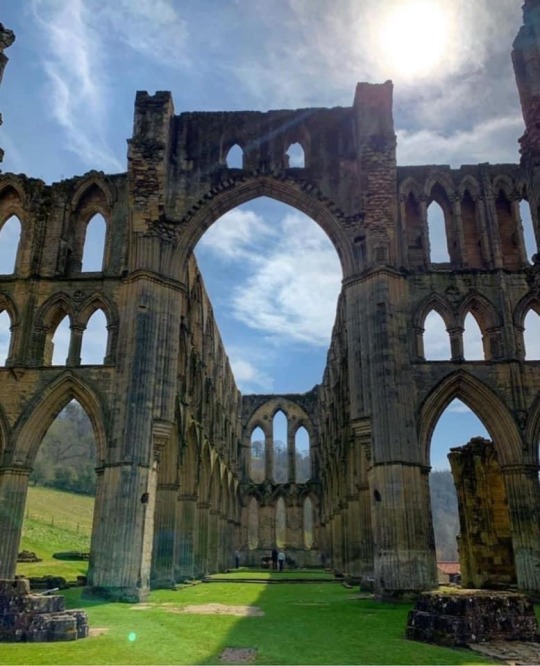
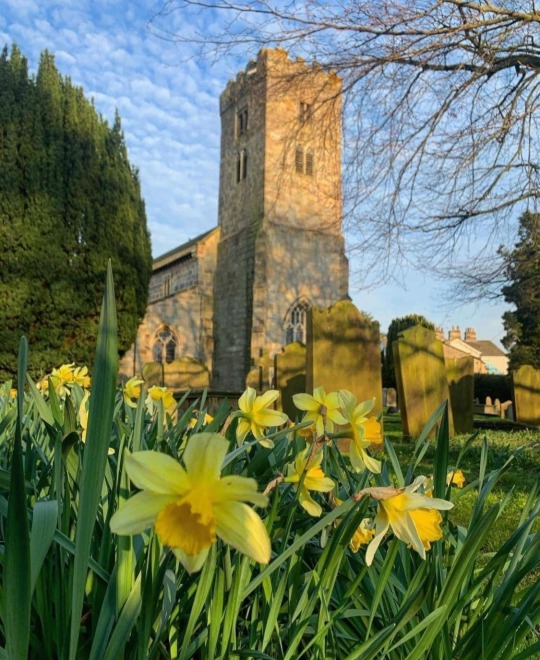

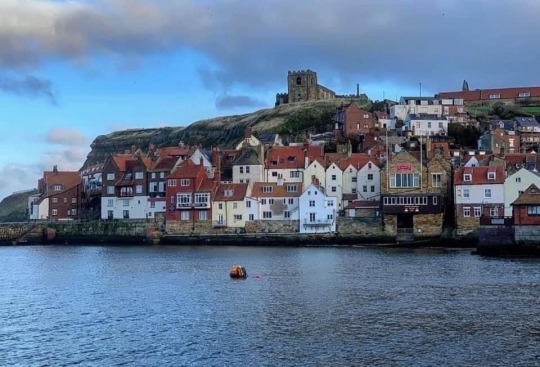
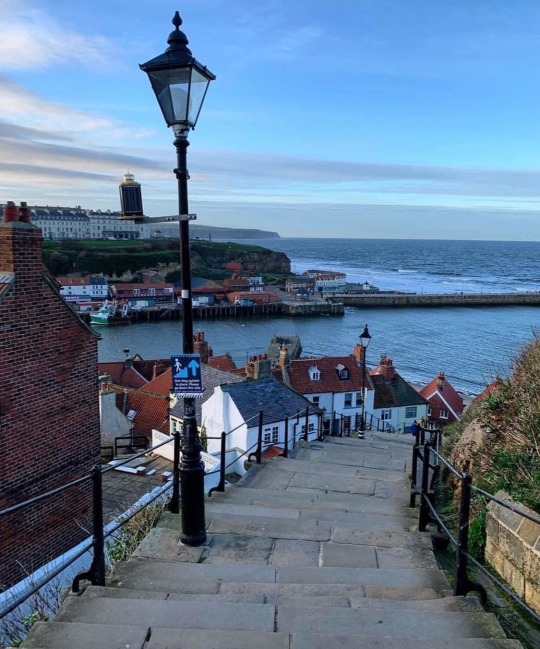
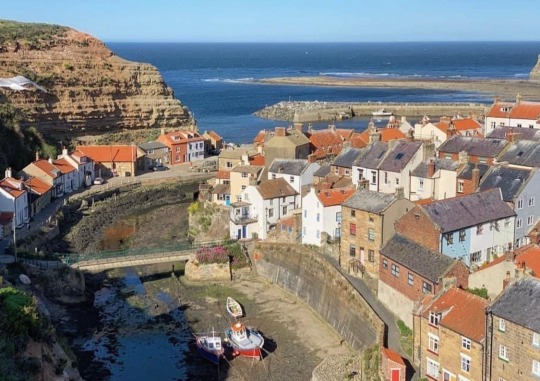

Ay up folks, its Yorkshire Day! A celebration every year on 1st of August of this wonderful, diverse and culturally rich part of England.
Yorkshire ties as my favourite region in England with Northumberland and I flip flop between which one we want to end up living in (The Yorkshire Dales or the Northumberland coast). From its wild moorlands of Bronte country, to its bustling industrial mill towns of Leeds and Halifax, to its beautiful seaside towns and fisherman’s villages, the rolling hills and drystone walls of the Yorkshire Dales and beyond it isn’t hard to see why Yorkshire has earned the moniker “God’s own country” by its proud inhabitants. So to celebrate this wonderful place here’s a few facts about York’shr.
Yorkshire is the largest county in the UK and covers a large part of Northern England, that’s a whopping 2.9 million acres- ee ba gum!. It is BIG, so big that over the years it was often subdivided into smaller jurisdictions for admiration purposes, most notably the areas of North Yorkshire, South Yorkshire, West Yorkshire and the East Riding of Yorkshire. While each of these regions certainly has its own distinct geography, accent, culture and history to explore, Yorkshire as a whole has always continued to be recognised as a geographic territory and cultural region. Yorkshire may be big now but it used to be bigger! Until 1974 it covered parts of what are now County Durham, Cumbria, Greater Manchester, Lancashire and the Tees Valley. Yorkshire also has nearly a third of the total area of National Parks in England (the North York Moors, most of the Yorkshire Dales and part of the Peak District) covering a fifth of the region’s land area.
Yorkshire also lays claim to being home to some of Britain’s ‘oldest’ things including the oldest known city in Britain, Ripon, which was granted a charter by at least 886. Scarborough on the coast was Britain’s first seaside resort, established in 1660 after the discovery of the ‘healing’ spring waters which later would form the spa. The oldest registered visitor attraction in England is Mother Shipton’s Cave and Petrifying Well in Knaresbough, North Yorkshire which has been welcoming tourists since at least 1630. Sheffield FC is the oldest football club in the world founded in 1857. The county is also home to Britain’s oldest pub (and perhaps the oldest pub in the world), The Bingley Arms in Bardsey dates from AD 953 to the days of the Vikings and has been serving beer for over 1,000 years. Speaking of pubs, Yorkshire is also home to England's highest pub, The Tan Hill Inn which sits 1,732 ft above sea level at a point where the counties Yorkshire, Durham and Cumbria meet. You might recognise it from the Christmas Waitrose advert where everyone got snowed in!
As well as the ‘oldest’, Yorkshire lays claim to some other great feats! The county has over 2,600 ancient monuments of national importance (14% of the English total), 800 conservation areas and 116 registered parks & gardens. The North York Moors Railway is the longest steam operated railway in the UK, with over 18 miles of track running through the countryside from Pickering to Whitby. The city of York has the longest city walls in England, at three miles long, and they enclose an area of around 263 acres. York Minster is the largest Gothic cathedral in Northern Europe, it took 252 years to build in its present form and contains 128 medieval stained glass windows and York’s Shambles is considered to be the best-preserved medieval street in Europe.
The emblem of Yorkshire, the white rose of the House of York is instantly recognisable for many and flies on flags across the county. The county is well known for its distinct culture, from its dialect to its food. This county gave us Parkin, Yorkshire curd tarts, Wensleydale cheese, Pontefract cakes and by far its most outstanding contribution to English culture; the Yorkshire pudding which makes up THE MOST IMPORTANT part of our Sunday dinner!
The unofficial anthem of Yorkshire is the popular folk song On Ilkla Moor Baht ‘at (“On Ilkley Moor without a hat”) which showcases some of the distinct words and pronunciations the region is known for. The dialect is old and has roots in Old English and Old Norse, being known as Broad Yorkshire or Tyke. Known for expressions like ayup, reet good, put ‘wood int ‘ole (close the door), shut thee cake oyle (shut your mouth) this county is still a glorious bastion of reet proper English as it was meant to be, home to northern and regional diversity that is fast disappearing. I will leave you to puzzle over this poem by about Yorkshire by Eric Scaife;
We’re a rare strange bunch ‘at live up ‘ere
But we’ve gradely grub an’ champion beer
An’ mony a famous name thou’l see
On Yorksheer own proud family tree.
Oor sportin’ ways are second ter none
Oor art an’ culture speak as yan
Us Yorksheer fowk ev Yorksheer ways
An’ when we say we laiks we plays.
Oor language is t’ English true
Oor thee, thou, tha’s are nothin’ new
Wi’ glottal stops an’ aitches dropped
The G at end is allus cropped.
So com’ thi ways to oor grand county
An’ sample sum o’ Yorksheers bounty
Oor ales are grand, oor looance too
An’ friendly fowk to welcome thoo.
🫖 🍰 🫖🍰🫖🍰🫖🍰🫖🍰🫖🍰🫖🍰
So today lads and lasses ‘sit thi sen darn’, put yus feet up, hav’ a proper brew of Yorkshire tea and enjoy some of my favourite photos I have taken around Yorkshire. Happy Yorkshire Day!
13 notes
·
View notes
Note
A quick question sorry, I just recalled that tizian is crossing the ghost sea(if I'm remembering right) does that mean he's near our island?
Hi~
If quickly, then:
Yes!
They will meet at the end of the next update - albeit in a completely different way that they had hoped for and expected, and in much more difficult circumstances, on different sides;)
If expanded, and with additional details about the world and its structure:
Secunda is an archipelago of over a hundred islands (I drew a little over twenty on the map, but that's just because I'm a goose). Each island lived in isolation and closed for most of its history - and each of them can reveal a completely different structure of society, mentality, language and system of laws.
The South is also called the foggy islands, a warmer and softer region in general understanding, with a more developed social and economic structure, the islands there are closer and larger, and the climate is more reminiscent of northern Britain.
The North is isolated and closed lands, small islands in a heavy, cruel and predatory, like the most distant regions of Norway - inhabited by not so many peoples, how many isolated cults, outcasts from the south and the darkest covens.
The archon was born and raised in Nimrode, one of the oldest and most northern places - and, having lived there for many decades, together with their darker talents, they was able to turn the endangered clan into a complete house, one of the largest and most powerful in these regions.
At this time, Tizian is a nomad from the continent, from distant and dark Colchis, and together with his clan he moved north from the witch hunt. Counting on success and a better life in the society of sorcerers, as well as relying on the opinions and experience of the Archon, he crosses the Sea of Ghosts - and on the southern islands he hope to find their place and meet his soul mate under any circumstance that is given to him.
Together they are to meet on Saugunt, the unofficial southern capital - but they will be separated by circumstances that will have a heavy impact on the lives of both of them, yet at the same time they will affect each other at a distance. While the Archon will take care of Tizian's family and coven, he himself will influence the formation of their success and place in high society, forcing their new overlords to cooperate with the Archon in order to cope with his influence on the cities.
khm
Such are the things ˙꒳˙
Thank you so much for your questions!!;зз
7 notes
·
View notes
Photo




Secret Clubs, Gatherings, & Societies: Fantasy & Mystery Picks
The Invisible Library by Genevieve Cogman
Irene must be at the top of her game or she'll be off the case - permanently...
Irene is a professional spy for the mysterious Library, which harvests fiction from different realities. And along with her enigmatic assistant Kai, she's posted to an alternative London. Their mission - to retrieve a dangerous book. But when they arrive, it's already been stolen. London's underground factions seem prepared to fight to the very death to find her book.
Adding to the jeopardy, this world is chaos-infested - the laws of nature bent to allow supernatural creatures and unpredictable magic. Irene's new assistant is also hiding secrets of his own.
Soon, she's up to her eyebrows in a heady mix of danger, clues and secret societies. Yet failure is not an option - the nature of reality itself is at stake.
All These Beautiful Strangers by Elizabeth Klehfoth
In the last day of summer, Grace Fairchild, the beautiful young wife of real estate mogul Allister Calloway, vanished from the family’s lake house without a trace, leaving behind her seven-year old daughter, Charlie, and a slew of unanswered questions.
Years later, seventeen-year-old Charlie still struggles with the dark legacy of her family name and the mystery surrounding her mother. Determined to finally let go of the past, she throws herself into life at Knollwood, the prestigious New Englandschool she attends. Charlie quickly becomes friends with Knollwood’s “it” crowd.
Charlie has also been tapped by the A’s—the school’s elite secret society well known for terrorizing the faculty, administration, and their enemies. To become a member of the A’s, Charlie must play The Game, a semester-long, diabolical high-stakes scavenger hunt that will jeopardize her friendships, her reputation, even her place at Knollwood.
As the dark events of past and present converge, Charlie begins to fear that she may not survive the terrible truth about her family, her school, and her own life.
The Rook by Daniel O'Malley
"The body you are wearing used to be mine."
So begins the letter Myfanwy Thomas is holding when she awakes in a London park surrounded by bodies all wearing latex gloves. With no recollection of who she is, Myfanwy must follow the instructions her former self left behind to discover her identity and track down the agents who want to destroy her.
She soon learns that she is a Rook, a high-ranking member of a secret organization called the Chequy that battles the many supernatural forces at work in Britain. She also discovers that she possesses a rare, potentially deadly supernatural ability of her own.
In her quest to uncover which member of the Chequy betrayed her and why, Myfanwy encounters a person with four bodies, an aristocratic woman who can enter her dreams, a secret training facility where children are transformed into deadly fighters, and a conspiracy more vast than she ever could have imagined.
Filled with characters both fascinating and fantastical, The Rook is a richly inventive, suspenseful, and often wry thriller that marks an ambitious debut from a promising young writer.
Sanctus by Simon Toyne
An explosive apocalyptic conspiracy thriller from a major new British talent that will set the world alight…
REVELATION OR DEVASTATION?
The certainties of the modern world are about to be blown apart by a three thousand year-old conspiracy nurtured by blood and lies …
A man throws himself to his death from the oldest inhabited place on the face of the earth, a mountainous citadel in the historic Turkish city of Ruin. This is no ordinary suicide but a symbolic act. And thanks to the media, it is witnessed by the entire world.
But few understand it. For charity worker Kathryn Mann and a handful of others in the know, it is what they have been waiting for. The cowled and secretive fanatics that live in the Citadel suspect it could mean the end of everything they have built – and they will kill, torture and break every law to stop that. For Liv Adamsen, New York crime reporter, it begins the next stage of a journey into the heart of her own identity.
And at that journey's end lies a discovery that will change EVERYTHING …
SANCTUS is an apocalyptic conspiracy thriller like no other – it re-sets the bar for excitement and fascination, and marks the debut of a major talent in Simon Toyne.
#fantasy#mystery#mysteries#mystery books#adult fantasy#ya books for adults#thriller#reading recommendations#Book Recommendations#to read#tbr#booklr#library#librarian picks
6 notes
·
View notes
Text
English History (Part 2): Mesolithic
Mesolithic Period (11,600 years ago [9600 BC] – 4000 BC)
At Formby Point (on England's north-west coast) are 8,000-year-old human footprints, continuing for about 9.75 metres. They include the footprints of children. The men were about 1.55m tall, and the women about 1.35m tall. They were looking for shrimps and razor shells.
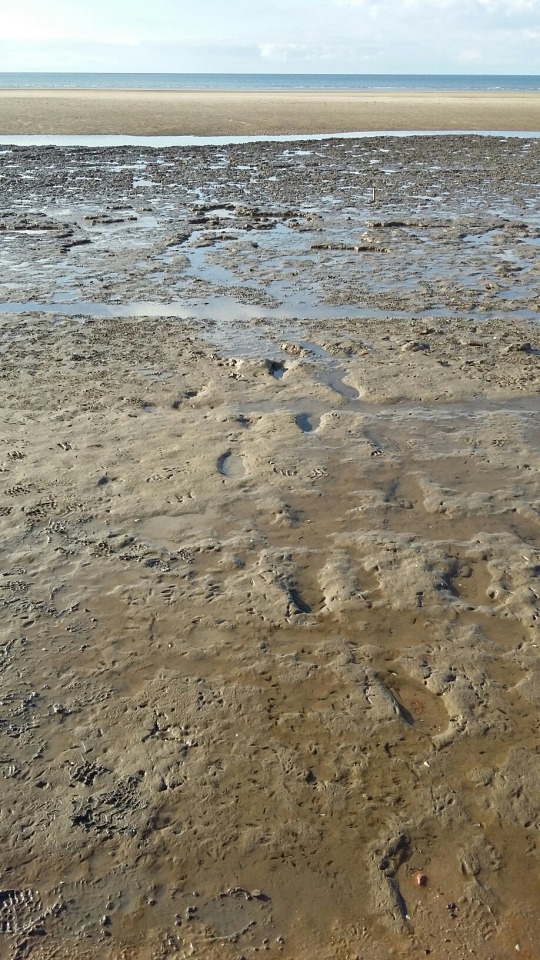
Formby Point footprints.
The Severn Estuary also has prehistoric footprints, from about 7,000 years ago. They fade away at the point where dry land once became swamp.

Severn Estuary footprints.
Mesolithic people burned the woods and forests to clear them, so they could build settlements or hunt for game more effectively. They also burned pine trees to make way for hazel trees – autumnal hazelnuts were a popular food source. They knew how to manage their resources.
Although they were “hunter-gatherers”, with dogs for hunting, the Mesolithic English did not just wander randomly. They ranged through group territories with well-defined boundaries that adjoined each other. They liked the areas where land met water.
Star Carr is a Mesolithic archaeological site in North Yorkshire, dating back around 11,000 years (to the early Mesolithic period). What is now the Vale of Pickering used to be covered in a great lake. A platform, made of birch wood, was built on the lake's bank. It may have been used for fishing, but probably was used for ritual ceremonial. The people wore amber beads, and left behind pig, red deer, duck and crane bones.
A round house, 3.5m in diameter, has also been found. It was made of 18 upright wooden posts, with a thick layer of moss & reeds so people could sleep on it. The house appears to have had a hearth; and the inhabitants used iron pyrite to start fires. They also used barbed antler points, and flint knices & scrapers.
The people of Star Carr used canoes to travel over the lake, and one paddle has been found. There are also 21 fragments of deer skull, some with antlers. They were probably used as shamanic masks or head-dresses, to enter the spirit of the deer. It may have been an early form of morris dancing.

Reindeer antler mask/head-dress from Star Carr.
Another Mesolithic settlement has been found at Thatcham (Berkshire), dating to around 8400 – 7700 BC, slightly younger than Star Carr. The people lived on the shores of a lake. Burnt bones, burnt hazelnuts, and patches of charcoal used for fires have been found. There are cleared spaces showing where small hut floors were.
There were hundreds of such settlements, many of them in coastal regions that now lie underneath the seabed. The coasts were once 21-30 metres higher than they are now, so settlements were lost as the seas rose.
One submerged village was found at Bouldnor Cliff off the Island of Wight. Divers saw a lobster flinging pieces of worked flint out of its burrow, and a settlement of craftsmen and manufacturers, hunters and fishermen, was revealed. A canoe carved from a log was found; so was a wooden pole with a flint knife embedded in it.
The Bouldnor Cliff site also has Britain's oldest boat building. Beneath it is a wooden platform from around 6000 BC, made of split timbers several layers thick, resting on round-wood foundations that were laid horizontally.
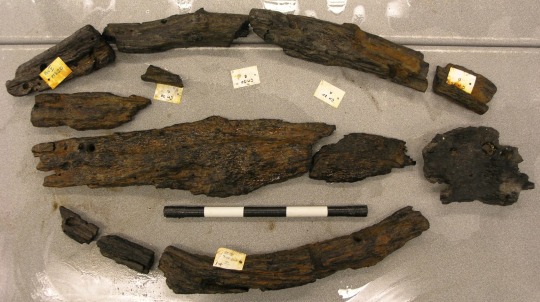
Tools found at Bouldnor Cliff.
The waters gradually rose; after the glacial era's ice sheets melted, it encircled the new archipelago of England, Scotland and Wales. This happened around 6000 BC, with the marshes and forests of the plains between England and the continent were obliterated by the southern North Sea. It probably took about 2,000 years overall, as the land slowly became swamp and then lake.
Earlier in prehistory, two huge floods had created the Engish Channel between England and France. Now with the newly-risen waters, 60% of the land surface became what is now England.
The tools made in England became smaller than those in continental Europe, and some types of microlith were unique to England.
Travellers still came to England from the continent – from north-western Europe, and the Atlantic coasts of Spain and south-western France. The migrations from the Atlantic coast were not a new phenomenon. These people had been colonizing the south-western regions of England throughout the Mesolithic, and by the time the archipelago was formed, a distinctive culture was flourishing in the western parts of England.
Those coming from Spain also settled in Ireland. “Hibernia” is the Latin name for Ireland, and is related to the word “Iberia”. The Iron Age tribe of the Silures (South Wales) always believed that their ancestors had come from Spain some time in the distant past. Tacitus stated that these tribal people had dark complexions and curly hair. They were later known as the Celts.
So by 8,000 years ago, there were already distinctions between the English regions. England's flint tools are divided into five categories. Those in the south-west had a different appearance to those in the south-east, which encouraged trade between the two regions. Individual cultures were being created, reinforcing geographical & geological identities (such as cultures established upon chalk & limestone vs. granite).
England can be divided into two zones – the Lowland Zone and the Highland Zone. The Lowland Zone covers the south and east (the midlands, Home Counties, East Anglia, Humberside, and the south central plain). It is built upon soft limestone, chalk and sandstone; it has low hills, plains and river valleys. It is a place of centralized power and settlement.
The Highland Zone covers the north and west, including the south-west corner of England (the Pennines, Cumbria, North Yorkshire, the Peak district of Derbyshire, Devon and Cornwall). It is mostly built upon granite, slate and ancient limestone; it has mountains, high hills and moors. It is a placce of scattered groups or families, independent from each other; it is hard, gritty and crystalline.
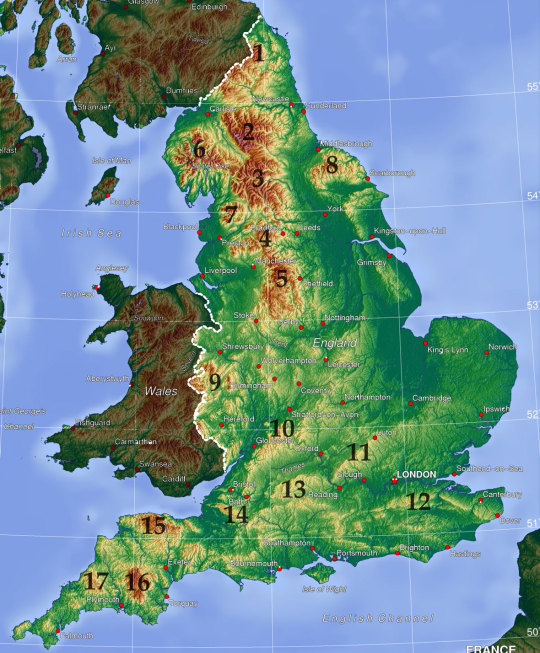
These two zones did not face each other. They faced outwards, towards the seas. The changes can be seen upon the ground itself. In Wessex, artifacts from one settlement stop where the chalk meets the Kimmeridge clays, showing that the people would move no further west. So regional differences began to spread.
Differences of accent & dialogue may already have existed. There was a language in the south-east that left traces in contemporary English – the words London, Thames and Kent have no known Germanic/Celtic root.
The people of East Anglia & the south-east may have spoken a language that developed into Germanic, and the people of the south-west one that became Celtic. The Germanic tongue would become Middle English and then Modern English; Celtic split into Welsh, Cornish and Gaelic.
In Wales and Cornwall, stones carved with Celtic inscriptions (from the Roman Age) can be found, but none have been found in southern England. Tacitus stated that by the time of Roman colonization, the south-eastern people spoke a language not unlike that of the Baltic tribes.
#book: the history of england#history#prehistory#geography#geology#classics#languages#linguistics#mesolithic period#britain#prehistoric britain#mesolithic britain#celtic britain#england#ireland#wales#formby point#severn estuary#star carr#isle of wight#bouldnor cliff
37 notes
·
View notes
Photo

Wymering Manor
Portsmouth, England
It’s steep history and active paranormal happenings make Wymering Manor the winner of this year’s Most Spooky House award. Known as Britain’s most haunted house, the Manor is supposedly home to upwards of 18 ghosts. In fact the home, which was up for sale since 2006, was eventually given away by the City Council to the Wymering Manor Trust in 2013 since the home was seen by potential home-buyers as too haunted to inhabit.
Wymering Manor is the oldest building in Portsmouth. The land that it was built on was once the site of an ancient Roman settlement. The original building was eventually built in 1048 when it was owned by King Edward the Confessor. In 1084 the home was owned by King William the Conqueror after the Battle of Hastings. During the 16th century the house underwent new construction. Although most of the Manor today dates back to the 16th century, there are still parts that feature its original Saxon and Roman materials. In more recent times, the home was turned into a country house, used by the army during WWII, and served as a YHA Hostel.
With all of its history, it is perhaps of little surprise that the home is extremely haunted. There have been countless reports of hauntings, as well as numerous legends surrounding the building, over the years. During the early 1900’s the owner of the time, Thomas Parr, woke up one night to see his deceased cousin’s spirit standing at the foot of his bed. After talking to Thomas about other members of the family, who were also deceased, she told him goodbye. Before fading away she said that the deceased family was getting ready to “greet their Aunt Em.” The next morning Parr received a telegram stating that his Aunt Em had died during the night.
Another relative of Thomas Parr who visited the manor used to keep her bedroom door locked at night while she slept due to a fear of burglar’s. Upon waking up one morning she was astonished to see that her door was unlocked and wide open.
Then next owner, Leonard Metcalf, had several strange occurrences while he lived at the Manor. Metcalf’s room used to be in the “Paneled Room,” which is one of the homes most feared rooms. One day while Metcalf was using the washbasin, he felt a hand place itself upon his shoulder. Quickly turning, he was shocked to find that no one was standing there. Others who have visited the home have felt that the atmosphere is oppressive. Many people felt fear surrounding the room, and had a powerful urge to run out of its doors.
Other than his experience in the Paneled Room, Leonard Metcalf would also occasionally see a choir of nuns crossing the Manor’s hall at midnight. Each of the nuns would be chanting to music that could clearly be heard. Leonard could never understand why he would see the nuns, and he could never get his family to believe him. Although he never knew it, it was eventually discovered that the Sisterhood of Saint Mary the Virgin had visited the house in the mid-1800s.
The ghostly choir of nuns is not the only nun sightings in the home. Outside of the Manor’s small attic bedroom, directly above the Paneled Room, the spirit of a nun with hands dripping with blood can be seen peering down the staircase leading to the attic. Some believe that the attic was where abortions for illegal pregnancies between monks and nuns were held before the infant bodies were later buried in the garden.
Another spirit seen at Wymering Manor is that of Sir Francis Austen, a distinguished Naval officer and brother of the famous novelist, Jane Austen. He was at one point the churchwarden of St. Peter and St. Paul, so he may have visited the Manor when the manor was a vicarage. After his passing, he was buried in a nearby churchyard of the Wymering Manor Church. Now it is believed that he haunts Wymering. One paranormal investigation group caught the figure of a tall man walking around whom they believed to be Sir Francis Austen.
The Legend of Reckless Roddy also surrounds Wymering Manor. According to legend, during the Middle Ages a newlywed couple came to the Manor. However, the husband was soon called away and the bride was left alone. Upon hearing this, Sir Roderick of Portchester, AKA Reckless Roddy, went to Wymering to try and seduce the young woman. The husband then returned home unexpectedly, chased Roddy out of the house, and killed him as he attempted to mount his horse. Now legend states that whenever a newly married couple comes to stay at the Manor, they will hear the sound of Reckless Roddy’s Horse galloping down the Lane. Despite not being aware of the legend, Leonard Metcalf and his new wife, sometime right after their marriage, were awakened by the sound of a horse galloping down the lane. Mr. E. Jones, the warden of the youth hostel, also reported hearing a horse galloping around the manor at night, although he was not newly married.
Finally, other than specific spirits inhabiting the home, both visitors and paranormal investigators have felt cold spots, heard disembodied voices, a piano playing, a baby crying, and sounds of children laughing. Apparitions of men and women can be seen descending the manor’s staircases, and poltergeist activity has also been reported.
8 notes
·
View notes
Text
Events 5.9 (before 1960)
328 – Athanasius is elected Patriarch of Alexandria.
1009 – Lombard Revolt: Lombard forces led by Melus revolt in Bari against the Byzantine Catepanate of Italy.
1386 – England and Portugal formally ratify their alliance with the signing of the Treaty of Windsor, making it the oldest diplomatic alliance in the world which is still in force.
1450 – 'Abd al-Latif (Timurid monarch) is assassinated.
1540 – Hernando de Alarcón sets sail on an expedition to the Gulf of California.
1662 – The figure who later became Mr. Punch makes his first recorded appearance in England.
1671 – Thomas Blood, disguised as a clergyman, attempts to steal England's Crown Jewels from the Tower of London.
1726 – Five men arrested during a raid on Mother Clap's molly house in London are executed at Tyburn.
1864 – Second Schleswig War: The Danish navy defeats the Austrian and Prussian fleets in the Battle of Heligoland.
1865 – American Civil War: Nathan Bedford Forrest surrenders his forces at Gainesville, Alabama.
1865 – American Civil War: President Andrew Johnson issues a proclamation ending belligerent rights of the rebels and enjoining foreign nations to intern or expel Confederate ships.
1873 – Der Krach: The Vienna stock exchange crash heralds the Long Depression.
1877 – Mihail Kogălniceanu reads, in the Chamber of Deputies, the Declaration of Independence of Romania. The date will become recognised as the Independence Day of Romania.
1901 – Australia opens its first national parliament in Melbourne.
1915 – World War I: Second Battle of Artois between German and French forces.
1918 – World War I: Germany repels Britain's second attempt to blockade the port of Ostend, Belgium.
1920 – Polish–Soviet War: The Polish army under General Edward Rydz-Śmigły celebrates its capture of Kiev with a victory parade on Khreshchatyk.
1926 – Admiral Richard E. Byrd and Floyd Bennett claim to have flown over the North Pole (later discovery of Byrd's diary appears to cast some doubt on the claim.)
1927 – The Old Parliament House, Canberra, Australia, officially opens.
1936 – Italy formally annexes Ethiopia after taking the capital Addis Ababa on May 5.
1941 – World War II: The German submarine U-110 is captured by the Royal Navy. On board is the latest Enigma machine which Allied cryptographers later use to break coded German messages.
1942 – The Holocaust in Ukraine: The SS executes 588 Jewish residents of the Podolian town of Zinkiv (Khmelnytska oblast. The Zoludek Ghetto (in Belarus) is destroyed and all its inhabitants executed or deported.
1946 – King Victor Emmanuel III of Italy abdicates and is succeeded by Umberto II.
1948 – Czechoslovakia's Ninth-of-May Constitution comes into effect.
1950 – Robert Schuman presents the "Schuman Declaration", considered by some to be the beginning of the creation of what is now the European Union.
1955 – Cold War: West Germany joins NATO.
0 notes
Text
Hello From Toronto - Exploring Chinatown and Kensington

In all my explorations of Toronto over the last few years I have learned that in addition to numerous world-class sights and attractions, Toronto has many lesser known nooks and crannies that are full of history, interesting stories and anecdotes. One of the best people to learn from about the twists and turns of Toronto's history is Bruce Bell, a well-known author, playwright, actor, standup comedian who is also a passionate historian and has become one of Toronto's most well-recognized history experts.
The story of how I met Bruce is also quite intriguing: my brother, who happens to live in Austria, was reading a German travel magazine that was featuring a story about Bruce, so he called me up and said that there is this guy that is doing all these neat walking tours through Toronto and that's how I connected with Bruce - through a European detour. Over the past couple of years I have taken two of his tours, covering the downtown area and featuring a culinary exploration of Toronto's famous St. Lawrence market. I have always enjoyed the experience and wanted to do another tour with Bruce for a while.
Well, I figured it was definitely time for more entertaining and informative explorations of Toronto; this time it was going to be Chinatown-Kensington, one of Toronto's most vibrant and fascinating neighbourhoods. So I called up Bruce and said let's do another tour. To share the experience I brought out six of my friends and we met yesterday at 6:30 pm at one of Toronto's modern architecture icons: the OCAD Building at 100 McCaul Street, just south of the University of Toronto campus. The OCAD Building, I call it the "gift box on stilts", is part of the 2004 redevelopment of the Campus of the Ontario College of Art & Design. The Sharp Centre for Design has a unique "table top" structure which has quickly become one of Toronto's most recognizable landmarks.
We met in the Butterfield Park area, surrounded by the stilts holding up the table top of this extraordinary building. From there we headed west into a green space that features Toronto's oldest house: "The Grange" was built in 1817 for D'Arcy Boulton Jr., a member of one of early Toronto's most prominent families who owned about 2000 acres of land in the area. The classical mansion reflects the British architectural traditions of the 18th century. Today, the Grange is owned by the Art Gallery of Ontario and is in the process of being renovated and integrated into the AGO's Frank Gehry-led redesign.
After leaving this park we walked north on Beverley Street which features several yellow-brick mansions of some of Toronto's most pre-eminent families, the "Family Compact" - the true power brokers of the early 19th century. Families such as the Cawthras and others owned huge tracts of land in what is today's downtown Toronto. The Bolton family even owned a private racetrack near the intersections of Dundas and Beverley and many formal social occasions were celebrated on their enormous estate. We also passed by a former hotel which dates back to 1822, one of the very few hotels left from that era which today is a men's residence.
Our stroll took us westwards on Baldwin Street, a street with a mix of imposing mansions, historic apartment buildings and narrow Victorian homes with attractive architectural details and amazingly intricate woodwork. Bruce stopped at a mansion of one of Toronto's most influential historic figures: George Brown (1818 to 1880) was a Scottish-born Canadian journalist, politician and one of the Fathers of Canada's Confederation. He was also the founder and editor of the Toronto Globe newspaper which today is known as the Globe and Mail.
Bruce enlightened us that George Brown was an important figure in the Underground Railroad, a network of secret routes and safe houses that allowed African slaves to escape from the United States to Canada in the 19th century. Ironically, as much as George Brown supported the cause of freeing black slaves, he remained a staunch anti-Catholic. Bruce elaborated that while the United States was characterized by an ongoing conflict between Blacks and Whites, early Canada's conflicts mostly unfolded between Protestants and Catholics. Bruce added that in 1880 George Brown was shot by one of his former employees at the Globe newspaper, a certain George Bennet who had been fired from his job for drunkenness. Although George Brown only suffered a leg injury at the time he died about 6 weeks later from the wound.
Just a few steps further west we saw the mansion of Robert Baldwin, a member of the Parliament of Upper Canada and a key public figure around the time of the 1837 uprising of the Toronto population against the entrenched British power structure. The unsuccessful Upper Canada Rebellion of 1837 was an uprising against the British colonial government, particularly about the issue of land allocation. Most of the land in and around the old City of York was owned by the "Family Compact", a group of extremely wealthy Anglican conservative families that represented Canada's elite at the time. Robert Baldwin was instrumental in establishing Responsible Government, which advocated increased independence from Britain and self-government for Upper Canada.
We had finally arrived on Spadina Avenue, the expansive north-south artery that is the centre point of Toronto's Chinatown. This historic neighbourhood, one of three Chinatowns within Toronto's city boundaries, is centered around Spadina and Dundas and is the largest Chinese shopping area in the city. Old Chinatown is actually one of North America's largest, not surprisingly as Toronto features the second largest Chinese population in Canada after Vancouver.
Recent years have seen a migration of Chinese immigrants to the suburbs which has led to the closure of some of the local restaurants. Many former Chinatown residents, originally from mainland China, Taiwan and Hong Kong have moved outside the City's boundaries and the void has been filled by many ethnic Chinese people from Vietnam. As a result an increasing number of store signs are now in Vietnamese, in addition to the well-established Chinese stores.
Goods sold include fruits and vegetables, meat and seafood, low cost clothing and general merchandise, all of which are sold at very reasonable prices. Recently there has been a noticeable local increase in Latin American immigrants, testament to the fact that Toronto's demographics continue to be in flux.
The same story applies even more to Toronto's Kensington area, roughly bounded by Spadina Avenue, College Street, Queen Street and Bellevue Avenue. As Bruce explained, it is one of Toronto's most ethnically diverse and eclectic neighbourhoods and has been attracting immigrants from different countries of origin for the last 130 years or so. Originally the Denison estate, the Kensington area became a residential area for Irish and Scottish immigrant labourers. The small working-class houses in this historically inexpensive area have been inhabited by successive waves of immigrants from different places. From 1910 onwards, Jewish immigrants from Eastern Europe as well as some Italians started to stream into the area. The entire Kensington area became known as "the Jewish Market", and about 60,000 Jewish residents lived here in the 1920s and 1930s who worshipped in about 30 local synagogues.
We stopped at the Minsker Synagogue at 10 St. Andrew Street, home of the Congregation Anshei Minsk, Toronto's Downtown Synagogue. Construction of the synagogue commenced in 1922 and was finally completed in 1930. As a result of the out-migration of many of the Jewish residents from Kensington, today it is one of the few synagogues still in active operation in downtown Toronto.
Captivated by the colourful and unusual variety of stores we walked through narrow streets filled with a jumble of vintage clothing stores, bakeries, restaurants, shops selling anything from fish, cheese and meat to dry goods and assorted merchandise. At about 7:30 pm most of the stores had closed or were in the process of closing, but the diverse and unusual storefronts and murals illustrate the Bohemian flavour of this area. Bruce pointed out numerous favourite hangouts: places such as Cob's Bread, Graffiti's Bar and Grill, My Market Bakery, the Chocolate Addict and many other unique nooks and crannies illustrate the free-spirited character of this unusual neighbourhood. At the intersection of St. Andrew and Augusta we stopped to admire a "half a house" that was attached to some flat-roofed houses and the complex was then capped off on the other side by another "half a house".
One of the most poignant symbols of Toronto's multi-ethnic mixing is a restaurant called the "Hungary Thai", an eatery that surprisingly combines European and Asian culinary traditions originating in Hungary and Thailand. There is no better area than Kensington Market to come face to face with Toronto's culturally diverse makeup. Today's Kensington features residents and merchants from all over the world, including people of Latin, Caribbean, European and Asian origin.
Southwest of Augusta Avenue we turned onto Bellevue Square Park, a green space that is frequented by a very Bohemian crowd of people, representing some of Toronto's artists and counterculture. Kensington Market is one of the few areas that features Cannabis cafes and products, and there is a distinct marijuana culture that pervades the area, particularly on Bellevue Square Park. The northwest end of the park features a statue of Al Waxman (1935 to 2001), a Toronto actor who starred in a popular television series "The King of Kensington" and was involved in numerous charitable organizations and events. Bruce pointed out that Al's wife Sara is immortalized on a bench right next to the statue in a carving that says "Sara loves Al".
Right opposite the Al Waxman statue at the corner of Bellevue Avenue is another relic from Kensington's Jewish history. The Kiever Synagogue on Denison Square was built in 1912. Its twin towers are crowned with Stars of David which give it a distinct middle-eastern or Byzantine feel. Although many Jewish residents have left the Kensington area over the last few decades to move further north in the City, the Kiever Synagogue continues to be active and to offer religious services every Sabbath as well as educational services to the remaining Jewish population.
We proceeded southwards on Augusta Avenue until we reached Queen Street. At the corner of Augusta and Queen we stopped and Bruce made us aware of one of the emblematic statues guarding the entrances of Kensington: an oversized cat prancing on a globe, an appropriately offbeat symbol of this colourful neighbourhood.
Across the street Bruce pointed out the former Alexandra Park public housing complex that has been renamed the Atkinson Housing Co-op. Bruce explained that this residential complex was a major urban planning mistake and had become one of Toronto's most crime-ridden areas. In 2003 the former Alexandra Park became Canada's first public housing complex to be converted into a tenant-managed, non-profit housing cooperative, a move which has greatly improved the safety in this area.
At the intersection of Dundas and Queen Streets, right in the heart of Chinatown, Bruce stopped again to show us the Art Deco Victory Theatre, a former vaudeville theatre. He also explained that this theatre had at some point morphed into the Victory Burlesque, home of famous Gypsy Rose Lee, the famous burlesque dancer who became known for putting the "tease into striptease".
The history of the Spadina area is colourful indeed. Jewish immigrants from Eastern Europe settled in the area from 1832 onwards, but major immigration got into full swing in the 1890s. Many of these poor Jewish immigrants had little language skills and began to work in low-paying jobs in the garment factories that had sprung up near Spadina.
Numerous Jewish delicatessens, tailors, cinemas, Yiddish theatres, synagogues and other political, social and cultural institutions developed in the area. Indeed, as Bruce pointed out, Spadina Avenue became the centre of the Garment District which still survives on a much smaller scale today - even today there are numerous fashion and fur stores that sell their merchandise to the public at wholesale prices. Bruce also elaborated that many of the buildings and warehouses became gradually higher, a direct result of the invention of the Otis safety elevator which made it feasible to carry out industrial manufacturing on higher level floors.
Our group then stopped at the Glen and Paul Magder Fur Store which was a pioneer in reforming Toronto's Sunday shopping laws by staying open on Sundays, despite heavy fines. Right around here we also got to admire the former location of a theatre owned by the parents of Mary Pickford, the famous Toronto born-actress, "America's Sweetheart" who became Hollywood's biggest star of the Silent Era. Together with Charlie Chaplin, Douglas Fairbanks, and D.W. Griffith, Mary Pickford was a cofounder of United Artists film studios.
We then walked east on Queen Street which features a whole stretch of eateries, restaurants and eclectic bars and taverns, including the Rivoli, an extremely popular bar, restaurant and pool hall. At the Horseshoe Tavern Bruce explained that many famous music acts of Toronto, including Blue Rodeo, got their start at this tavern.
Incidentally this was also a favourite hangout for the notorious Boyd Gang, a 1950s gang of bank robbers led by Edwin Alonzo Boyd. The gang garnered a lot of media attention due to its sensational actions, including bank robberies, jail breaks, liaisons with beautiful women, gun fights and daring captures. Two of the gang members were captured and hanged for the murder of a policeman in 1952 while Edwin Boyd, by then a Canadian folk hero, was sentenced to eight life terms plus twenty seven years concurrent. He was paroled in 1966, relocated to British Columbia and died in 2002.
Just steps further east is the "Friendship House", where Russian refugees were taken in, it is also the centre of the Communist League of Toronto and the former location of the 1980s television series "Street Legal".
A few steps east is a series of Victorian townhouses that, as Bruce explained, were owned by two sisters who had had a serious falling out. Although the buildings were symmetrical in appearance the sisters did their best to modify the architecture to ensure that each of their sides would look different from the other sister's property. Bruce pointed out a couple of former vaudeville theatres, explaining that in the era before cinemas and podcasts, almost every city block had one or more of these theatres which were popular entertainment spots for the locals.
At the Corner of Queen and Soho is the Black Bull, a decades old hotel and tavern that features a spacious outdoor patio. Bruce explained that in the 1800s Toronto's city limits extended to Peter Street, and the tavern housed in this building was the last tavern on the way out of town. This was at a time when a horse and carriage ride to Niagara Falls could take two days, so a final watering hole on the outskirts of town was important.
Another significant Toronto landmark rose up impressively in front of our eyes: Toronto's CHUM City Building, the main studio complex of CTV Globemedia. The building houses City TV and its famous Speakers Corner video booth (which allows members of the public to voice their opinions on any topic), Cable Pulse 24, MuchMusic, Star! and the Fashion Television Channel. Its 1914 Neo-Gothic terra cotta façade make it an instantly recognizable landmark in downtown Toronto, and the news truck with the turning wheels that is built into the eastern façade make it a real icon of the downtown core.
Well, our informative and https://startupheretoronto.com entertaining Chinatown-Kensington Tour had come to an end. Bruce, with his dramatic abilities, was able to educate us and entertain us at the same time, introducing us to historically significant parts of the city that we had never seen or simply walked by without noticing.
1 note
·
View note
Text
Day 125: Hadrian’s Wall and the Scottish Borders
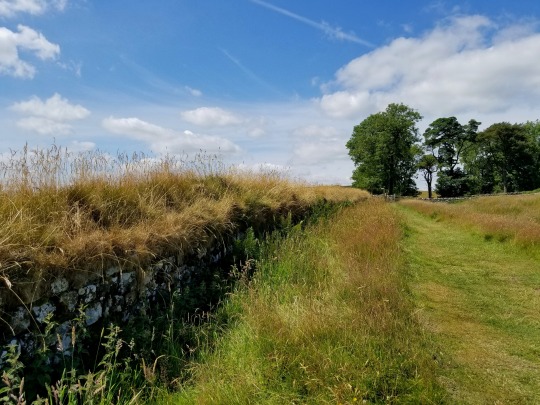
When we first started planning this trip, one of the big sites I'd wanted to see was Hadrian's wall. But it's so far from anywhere else we wanted to go in England that I had resigned myself to the fact that I probably wouldn't get to go. Luckily, Rabbie's offers a tour of the wall from Edinburgh. Not only would we get to see Hadrian's Wall, we'd get to approach it from the north like an old Celtic barbarian.
It was a long tour, so we had to get up and into town early.
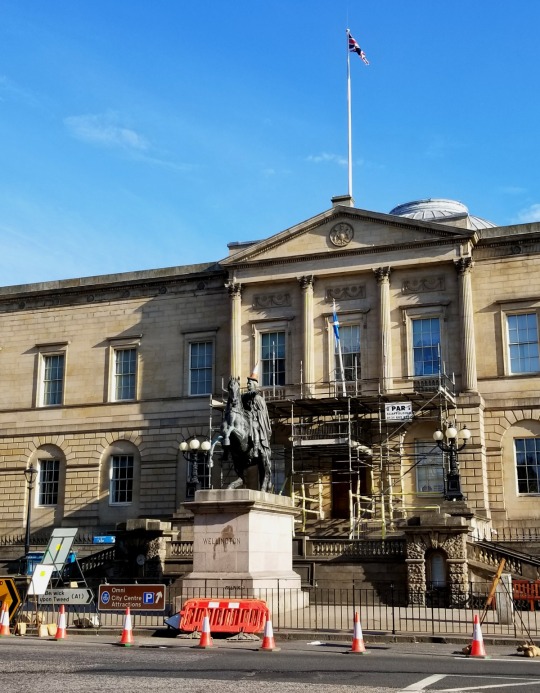
There must have been quite the party going the night before. Even the statues woke up with traffic cones on their heads.
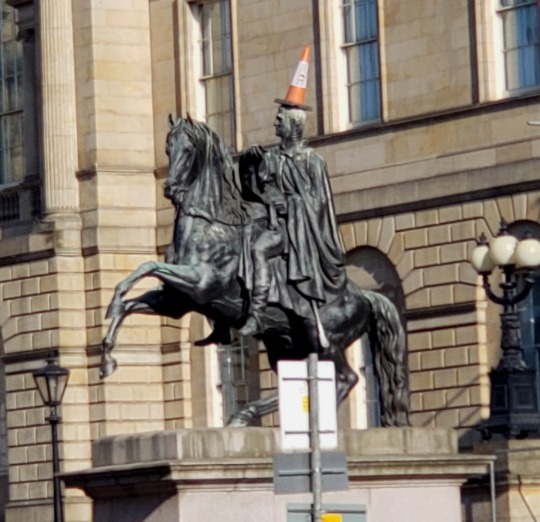
Our guide and driver for the day was Nik, a middle-aged, born-and-bred Edinburgh man with the accent and stories to prove it.
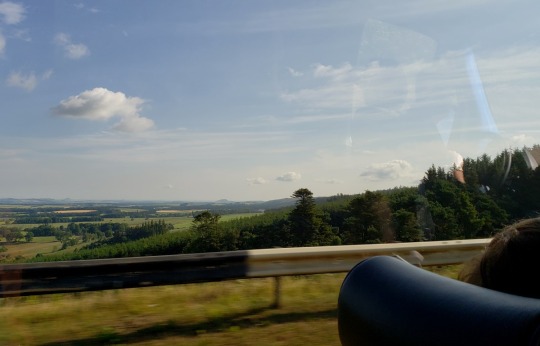
As we drove south, we passed through the beautiful rolling hill country that makes up the Scottish Borders. The Highlands are seem to get all the glory when it comes to romanticizing Scottish countryside, but the Lowlands definitely have their own idyllic charm.
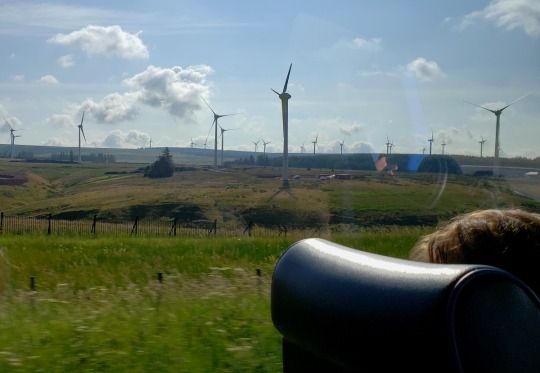
Nik told us some interesting stories about the medieval residents of the Borders and their complex relationship between England and Scotland. They were ethnically Scottish, but the Borderers resented both countries because their wars inevitably brought the razing and pillaging of border towns by both sides.
The Borderers were excellent horse riders and highly valued as mercenary cavalrymen throughout Europe. Whenever the English and Scottish armies fought in the Borders, the Borderers would hire themselves out to both sides, then sit on the sidelines of each battle until the winner was clear. They made special coats with English colors on one side and Scottish colors on the other, so they could flip their coats inside-out to match whichever side they decided to be "fighting for" at the moment. Hence the term "turncoats."
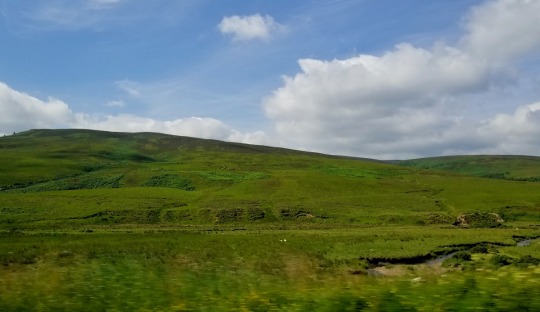
When they weren’t fighting as mercenaries, the Borderers spent a lot of time fighting themselves. One town would gather a raiding party and invade the next town over. That town would then gather a counter-raid to get their stuff back. Eventually, the raids became so bad that towns hundreds of miles away–well outside the Borders--were being raided by these crazy hill people. Neither country wanted to take responsibility for them, but when King James VI and I united Scotland and England under one crown, he was able to raise a police force to move in and establish order.
We also saw a lot of sheep on our drive. According to Nik, there are three sheep in Scotland for every man, woman, and child. Which is the perfect number, he said–one for meat, one for wool, and one for snuggling.
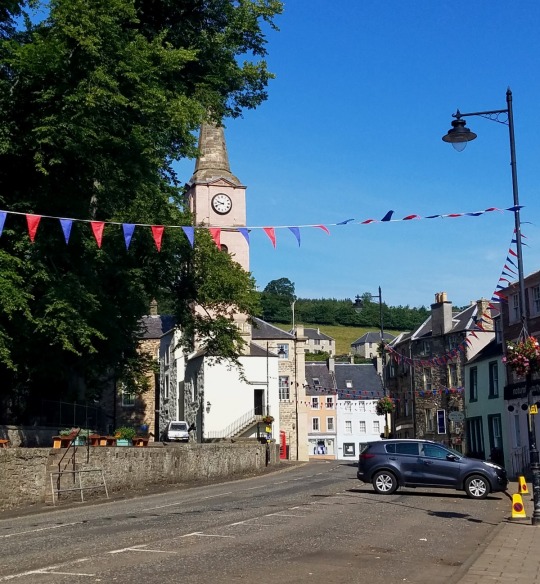
Our first stop was the abbey town of Jedburgh, just ten miles north of the border with England. Streamers hung up all over the town indicated that a festival was going on, but it was dead quite on this Thursday morning.
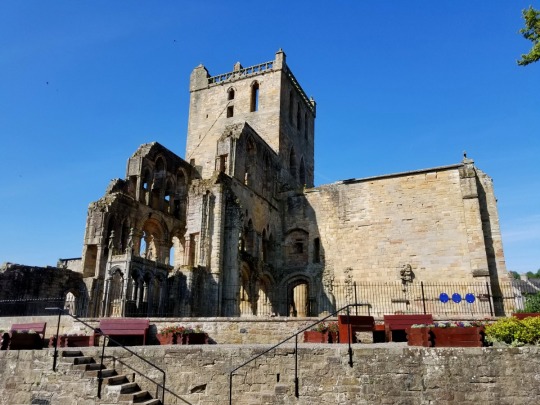
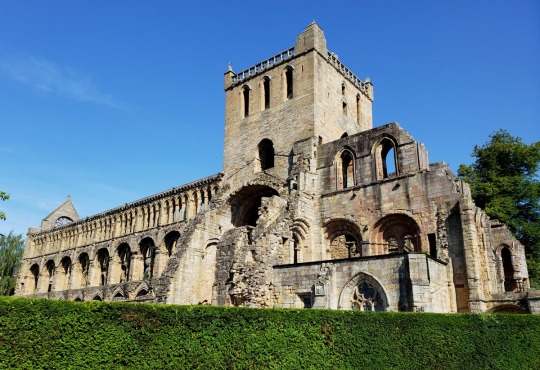
The abbey, like most abbeys in Britain, is only a picturesque ruin now. But this time it wasn't Henry VIII's fault--the Scottish destroyed their own abbeys during their own Presbyterian Reformation.
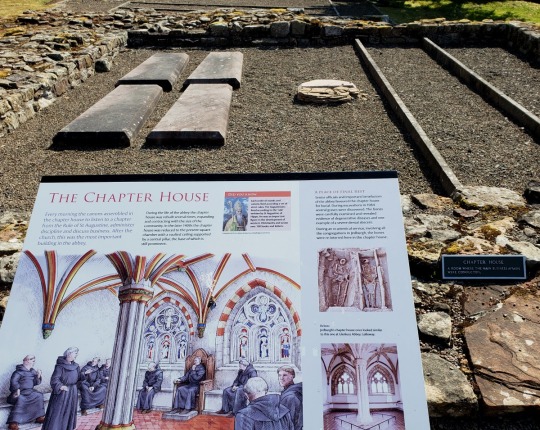
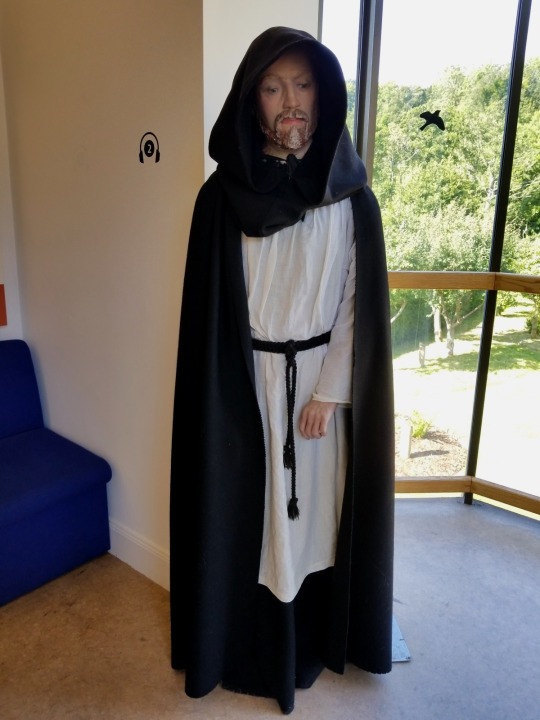
Before its destruction, the abbey was inhabited by Augustinians, who were known as cannons rather than monks. Whereas monks live and work in their abbey, cannons are priests who choose to live communally in an abbey but still teach and perform services in their local community.
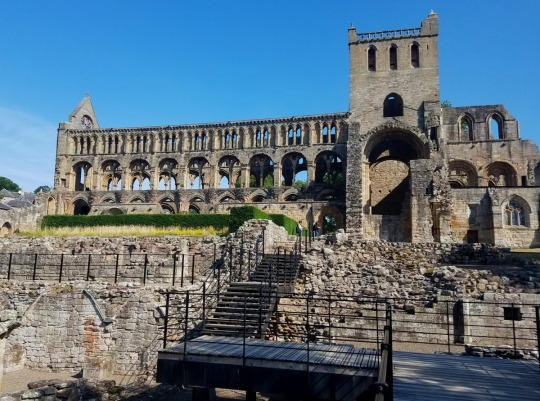
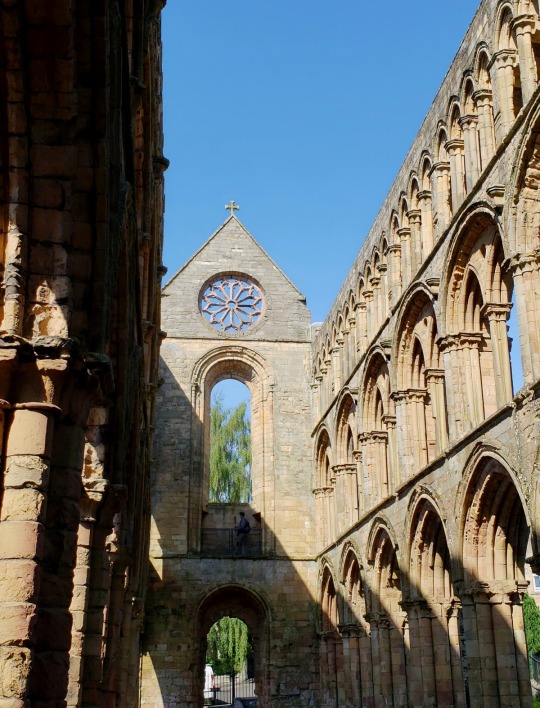

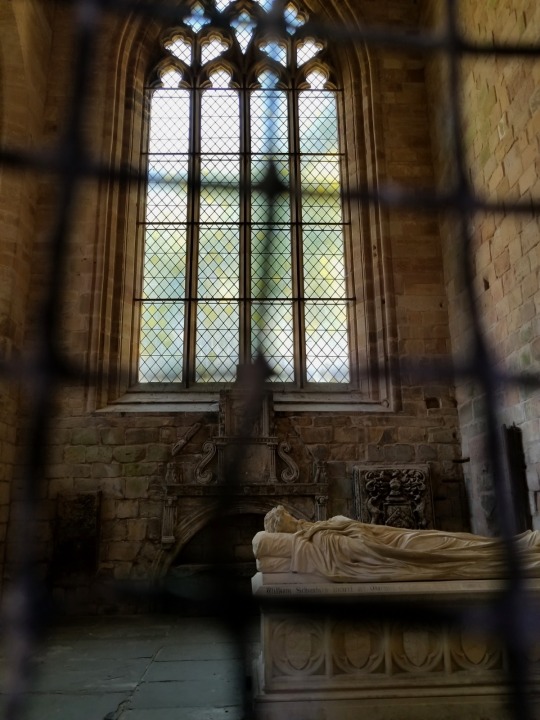
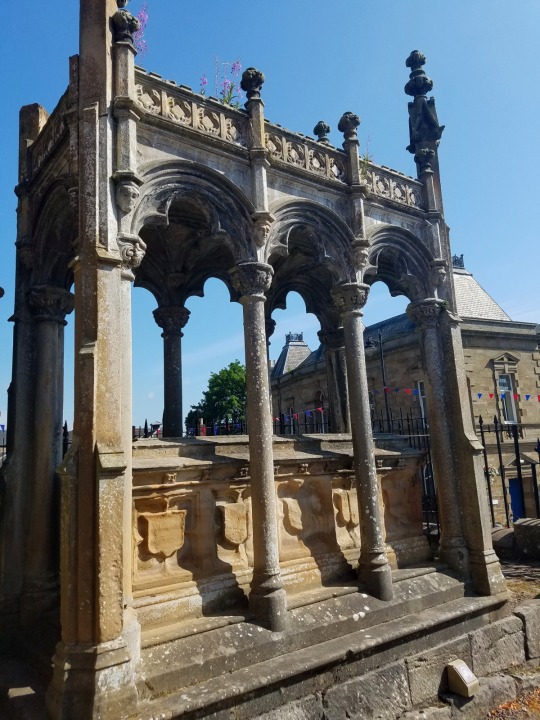
We got about an hour to explore the small museum and wander through the peaceful ruins.

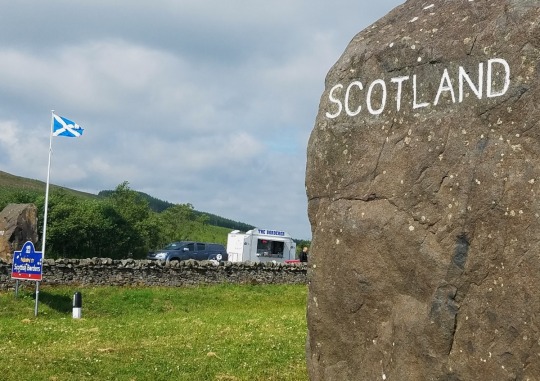
Next we headed down to the crossing between England and Scotland, where we pulled over for a quick photo op. There's no security or anything, just a pair of engraved standing stones.
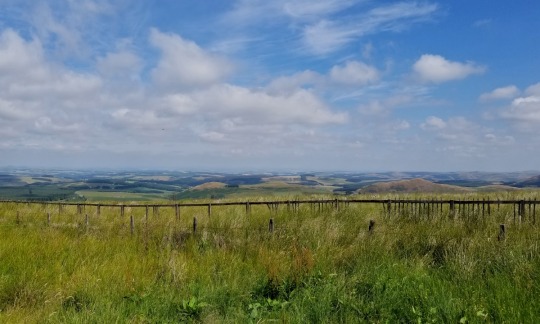
The view was fantastic, though.
Our timing was good, too. Just as our group finished taking pictures, a kilt-clad busker showed up to serenade us with his bagpipes. More oddly, a man driving through the parking lot stopped and called one of our group mates over so that he could give her some sort of "helpful" pamplet. According to Nik, this guy is a regular feature at the crossing who stages this sort of thing all the time, making it seem like he's just a friendly local who randomly decided to pull over and give the handout to a passing tourist.
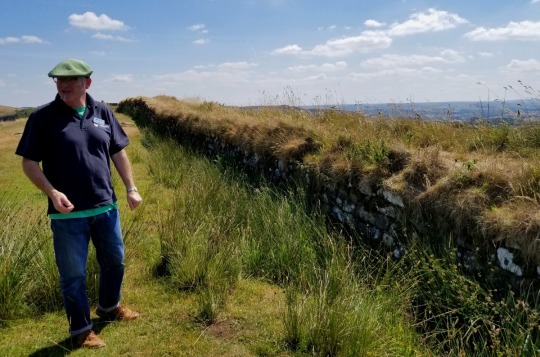

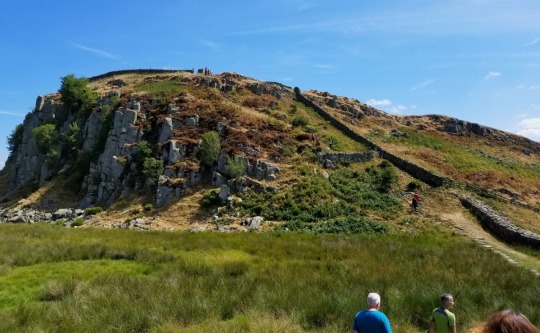
After a few very pleasant hours of driving (some of which my dad and I might have spent dozing), we arrived at Hadrian’s wall. Specifically, we arrived at Steel Rigg, a dramatic line of glacial crags that the wall runs along the top of.
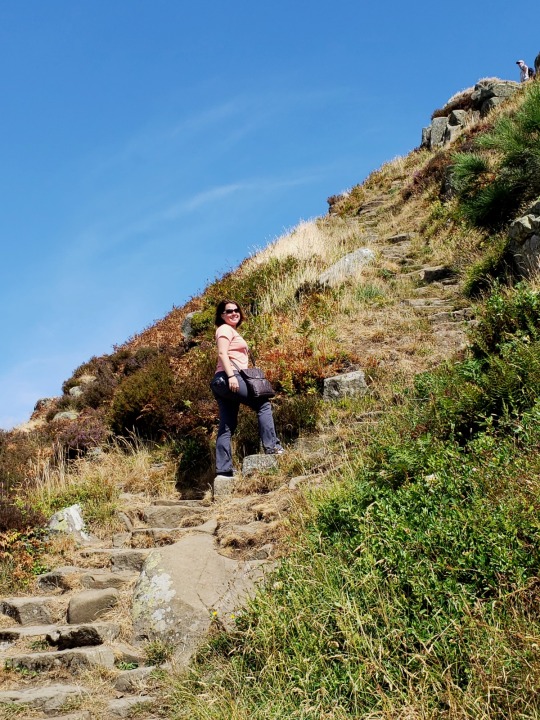

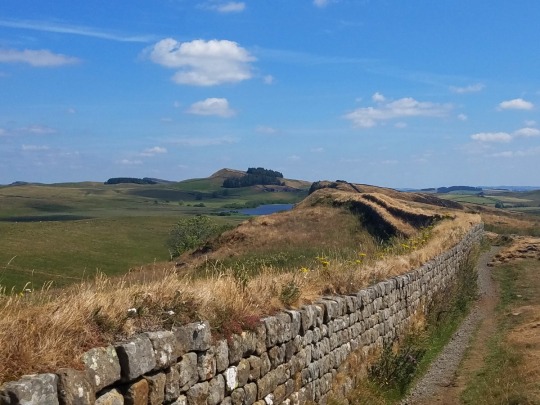
It was a steep climb up to the top of the outcrop, but the view was well worth it. Even if the wall was never really used as a defensive installation, it was easy to imagine hordes of painted Celtic barbarians massing to the north.
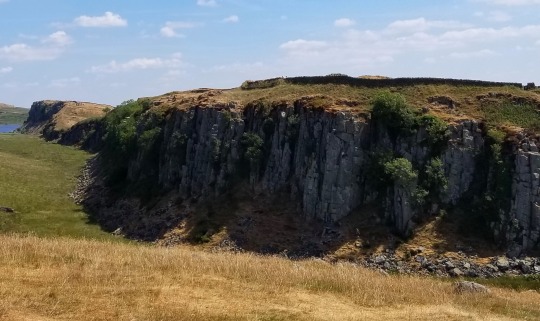
And seeing the way crags rise up like a wall themselves, I can very easily understand how George R.R. Martin was inspired by this place to create his fictional wall of ice in A Game of Thrones.
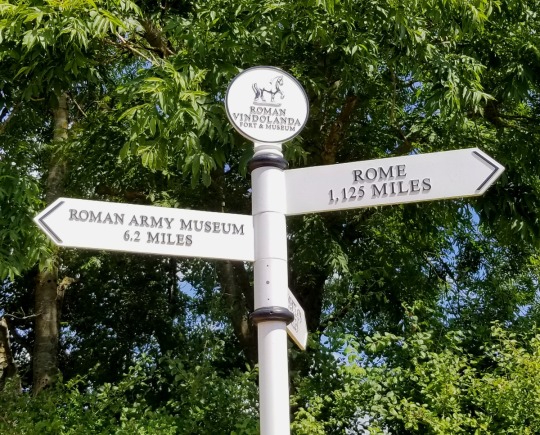
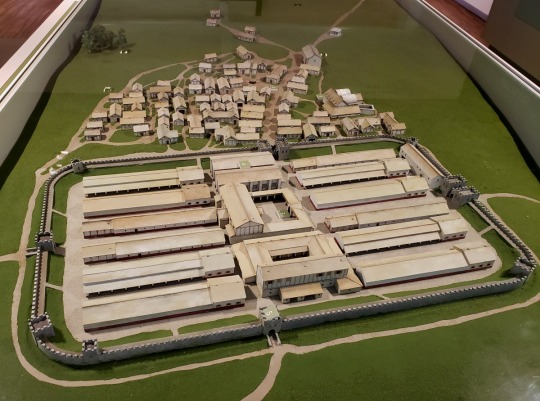
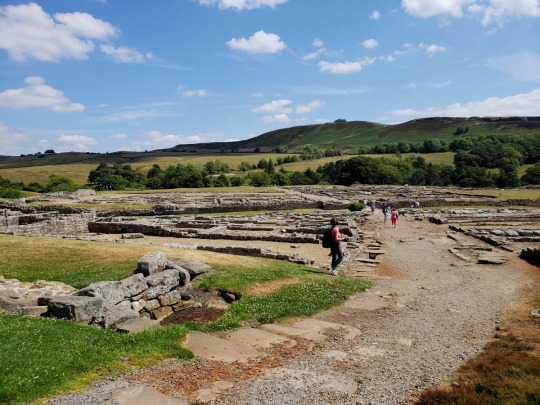
Next, we went to the nearby Vindolanda excavation and museum. Vindolanda was a Roman walled settlement inhabited by the soldiers who manned Hadrian's wall, as well as their families and the various merchants and artisans who supplied them. The site has been meticulously unearthed, and the included museum is filled with fascinating artifacts from the Roman inhabitants’ everyday lives.

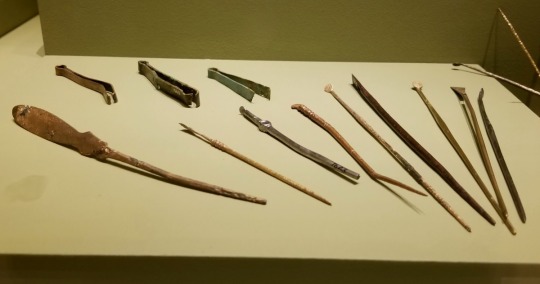


There was pottery, flatware, tweezers, and lots and lots of leather shoes. The Romans wore very intricate leather shoes, but apparently very few examples are still around. Vindolanda is a treasure trove of leather and wooden goods because the land it's on is basically a bog--pretty much the same story as with the Celtic artifacts we saw at the Irish National Museum of Archeology in Dublin.

Despite being such innocuous pieces, one of the collections that struck me the most was the wooden barrel staves on display. We could see the ancient branded markings in old Latin clear as day, and one stave still bore a round stain from when some Roman set something dirty on it. The world's oldest coffee ring, perhaps?
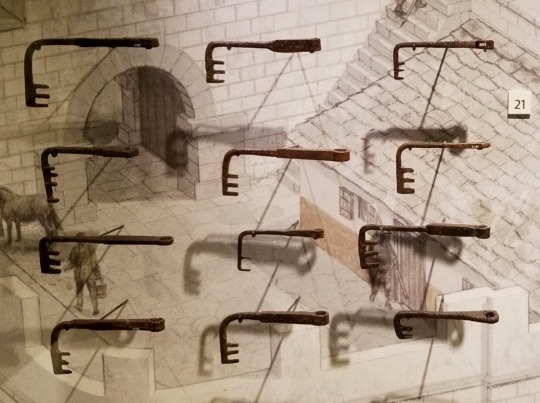
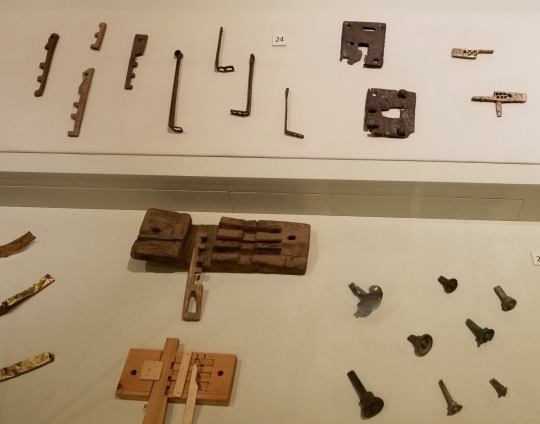
There was a fascinating collection of Roman locks and keys that were much more intricate than what I would have assumed they had at the time.
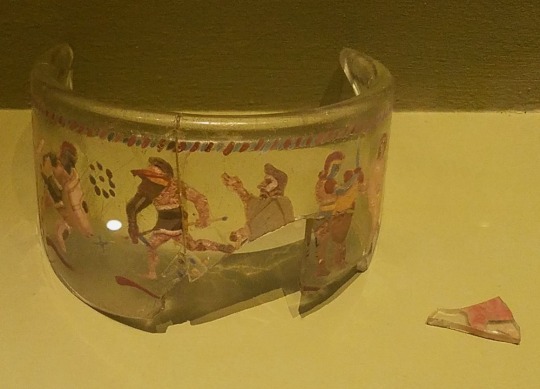
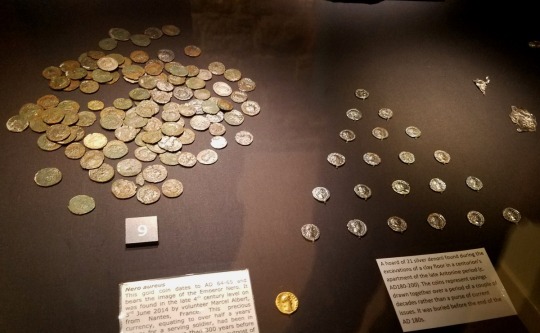
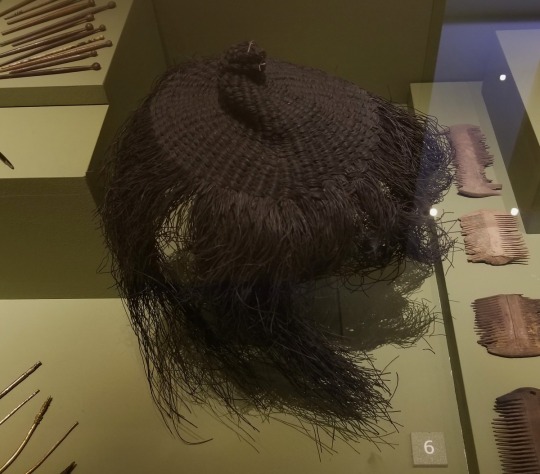
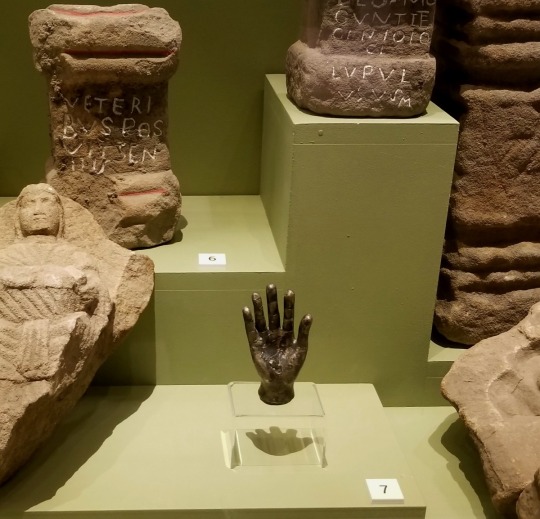
Other interesting finds in the museum included a piece of intricately painted glass that had been imported from Roman Germany, some surprisingly shiny Roman coins a bug-resistant wig made from local moss, and a small metal hand used for religious ceremonies.
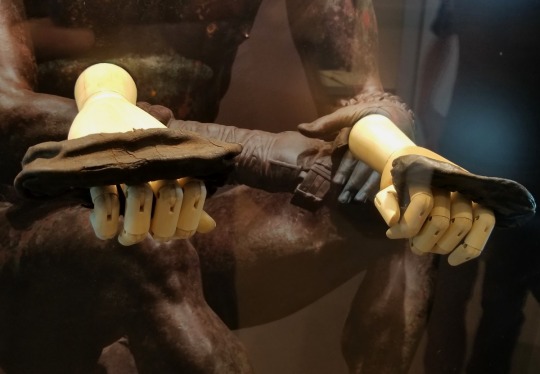
But the pride of the museum's collections was a barely distinguishable pair of leather boxing gloves. Boxing was a favorite pastime in the Roman Empire, and there are countless artistic depictions of soldiers and gladiators wearing an ancient form of boxing gloves. But these gloves found at Vindolanda are the only known surviving pair in the entire world.
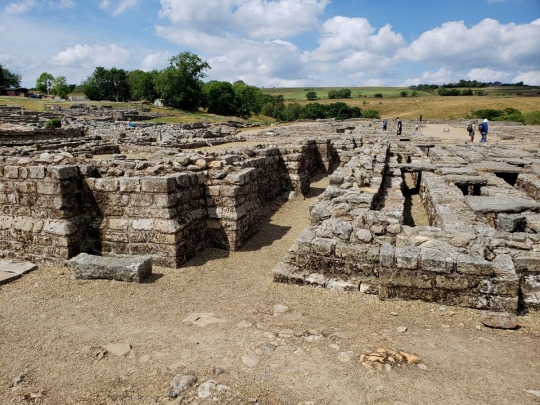

Normally, there is an afternoon guided tour of the ruins, but today's tour was replaced with a performance by a group of local Roman Legion reenactors.
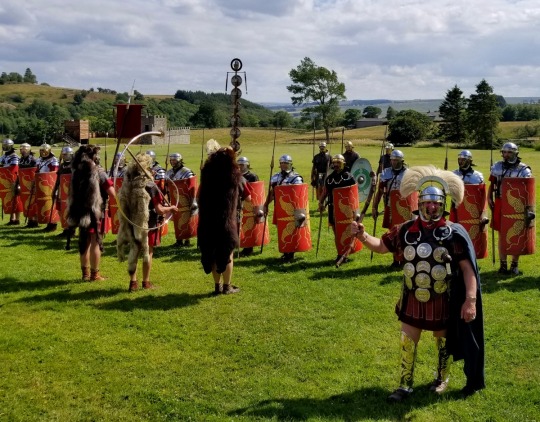

They described their arms, armor, and troop composition. We learned that up until the mid-20th century, historians didn’t actually know for sure how the iconic Roman segmented plate armor worked. It wasn’t until an old wooden chest under someone's house was discovered to contain two intact sets that people were able to accurately recreate them. And by recreating them, historians and reenactors can learn firsthand how they work and would likely have been used.

And you know you're in for a treat when your tour guide is excitedly taking pictures along with the rest of the group.

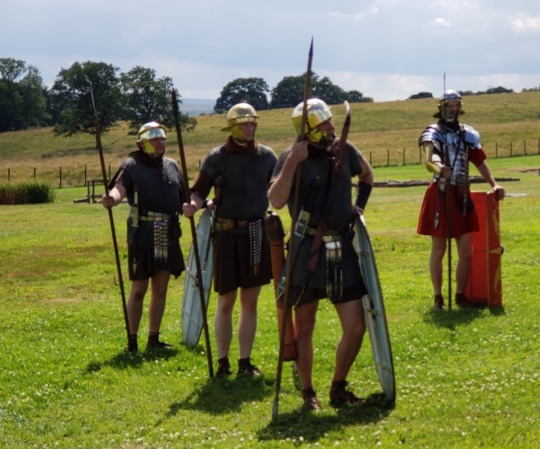
We learned how most of the soldiers manning Hadrian’s wall would not have actually been Legionnaires, but rather auxiliaries. Auxiliaries were non-citizen soldiers who fought for the Roman army in exchange for citizenship after 25 years of honorable service. In the meantime, they got less money, worse equipment, and more dangerous postings.

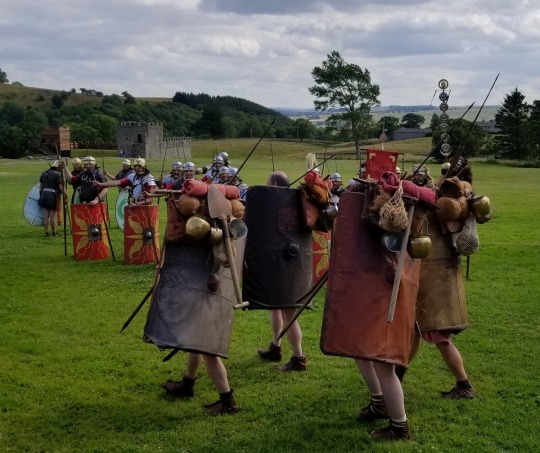
The reenactors also described how the invincibility of the Roman army was not just due to the superiority of their arms and armor. At the time, the Romans basically reinvented the idea of a professional, standing army. The Celts of Scotland had a proud and fierce warrior culture, but they didn’t really have armies. When one clan went to war against another, they would just gather all the able-bodied men together and head out. They were strong and fierce, but they just didn’t have the skills and tactics that full-time soldiers are able to develop through years of constant, structured practice.

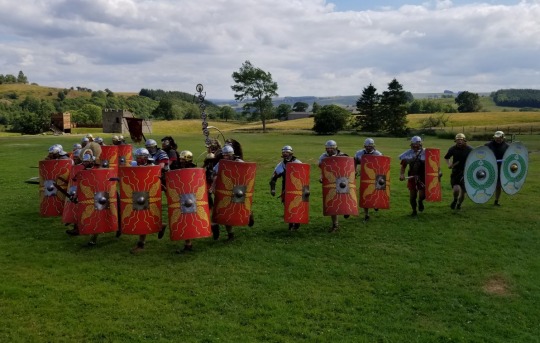
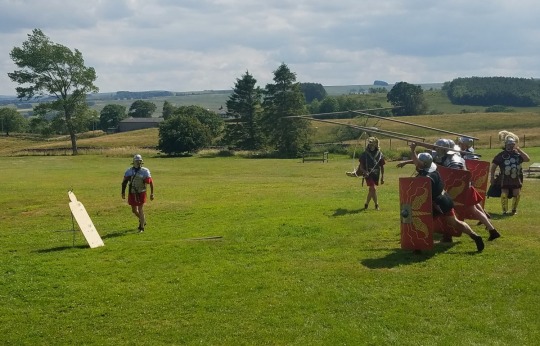
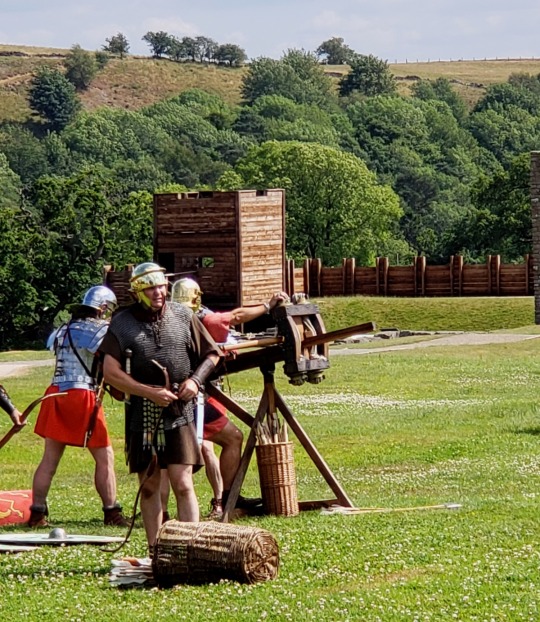
We got to see the reenactors charge, duel, throw spears, and even fire a ballista (basically a giant crossbow, for anyone who's never played Age of Empires).
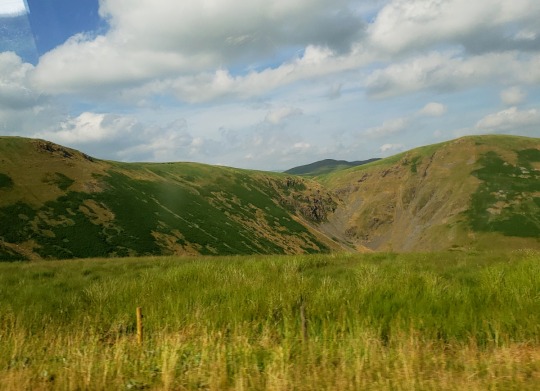
Leaving Vindolanda, we headed back up to Edinburgh through the western Lowlands. Again, the rolling hillsides were spectacular. I was especially enthralled by the area around the River Tweed, the home of a famous British textile. We could easily see how the raiding parties Nik described could hide out in a fog-cloaked ravine and become virtually unfindable. Nik also pointed out the particular hillsides where the wild haggis love to run free--in circles, of course, because of their naturally lopsided legs.
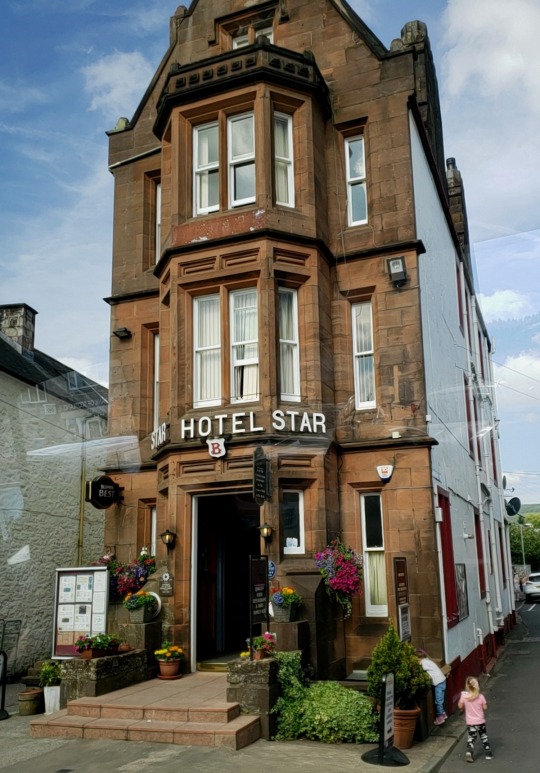
We also passed by the narrowest hotel in Britain.
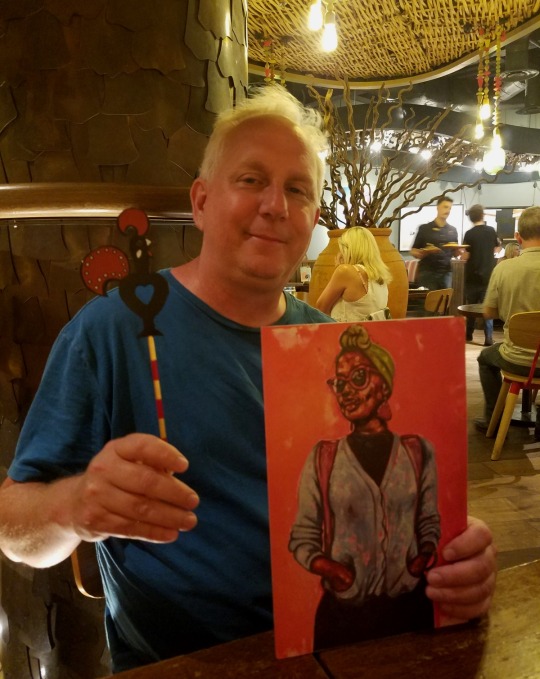
Back in Edinburgh, we finally got my dad his first taste of Nando's before heading back home. It was in a shopping mall at the edge of Old Town, and it was about an hour's wait between when we first put our names down on the waiting list and when we actually got our food. It was well worth it, though--especially considering that it would be our last Nando's of the trip.

Back home, we rested up and prepared ourselves for our last two days in Edinburgh. We would be staying in the city, and we had almost all of it left to see.
Next Post: Edinburgh, Part 2 (History, Hiking, and Beer)
Last Post: Glasgow
#180abroad#edinburgh#scotland#lowlands#scottish borders#hadrian's wall#vindolanda#ancient#rome#roman ruins#history#travel
3 notes
·
View notes
Text
London’s Magnificent 7: The Best Graveyards In The City

Despite sharing a name with a very popular group of gunslingers, the Magnificent 7 in the city of London means something very different. A taphophile is the term given to someone who likes to explore graves, cemeteries or tombs, and there is no judgement here. Exploring cemeteries is a great way to explore a lost culture, and learn about the inhabitants of previous generations when visiting an area.
Whatsmore, London’s cemeteries have some pretty amazing graves and some pretty amazing inhabitants. So make the most of the best London accommodation Lancaster UK has on offer, and explore the city’s past from the Park Grand London Lancaster Gate. The public transport links are incredible, so visiting the Magnificent 7 is a very easy thing to do! Let’s find out what makes these cemeteries special!
Abney Park Cemetery
The first cemetery in the UK to house an arboretum, it was partially abandoned for a period of time- ironically making it even more incredible. Nature started to reclaim the area, meaning it still has an eerie feel even for a graveyard. Incredible architecture and a wild urban feel give this place a unique vibe.
Brompton Cemetery
One of Britain’s oldest garden cemeteries, Brompton is actually one of the few that is still open for interment. Containing 35,000 graves spanning several centuries as well as several Grade II listed buildings, this is a special piece of London’s history.
Highgate Cemetery
Highgate is perhaps the most well known of the 7- not least because of the people buried there. The cemetery is actually a nature reserve and it shows. The trees and plants are allowed to grow, ivy covers the headstones and nature is in control. There are roughly 50,000 graves including the likes of famed author Douglas Adams and novelist Geroge Eliot.
Kensal Green Cemetery & Catacombs
Built to honour a cemetery in Paris, Kensal Green is a gorgeous piece of architecture before anything else. The home of 2 neoclassical chapels, 65,000 graves, 3 catacombs and several mausoleums. The final resting place of Isambard Kingdom Brunel, Oscar Wilde’s mother and the man who crossed Niagara Falls on a tightrope.
Nunhead Cemetery
One of the smallest cemeteries on the list, but also one of the prettiest. Nearly 2,000 gravestones once filled the area, although now some parts are so overgrown you could easily miss them. Offering views of St Paul’s through the trees, it’s a great place to explore!
Tower Hamlets Cemetery
Despite its relatively small size this cemetery is actually the final resting place of over 250,000 people. Situated in one of the poorest areas in London public graves were the only option for lots of people. The overgrown nature of this cemetery gives off a spooky vibe.
West Norwood Catacombs
West Norwood was the world’s first Gothic style cemetery. It used to contain chapels, but these were badly damaged in the war. The catacombs survived and the braver explorers among you can still descend and see the piles of coffins. Home to many famous names, this is really worth a visit.
If you’re staying in the best Hotels In Lancaster England you are well situated to see the city. So ensure that you make full use of your Hotels Near Lancaster Gate Station London, and explore the city’s past. These cemeteries will scare and enchant you in equal measure, so get out there and explore!
#accommodation Lancaster UK#Park Grand London Lancaster Gate#Hotels In Lancaster England#Hotels Near Lancaster Gate Station London
0 notes
Text
27 of the Best Things to do in Bermuda
New Post has been published on https://www.travelonlinetips.com/27-of-the-best-things-to-do-in-bermuda/
27 of the Best Things to do in Bermuda
Looking for things to do in Bermuda? Look no further, because you are going to love these ideas. Often mistaken for a Caribbean vacation destination, Bermuda is actually located in the North Atlantic Ocean, but thanks to the Gulf Stream, it remains a comfortable temperature throughout the year.
Bermuda is only a 2-hour flight from New York, 3-hours from Toronto, and less than 7 hours from London England, making it an ideal beach vacation for everyone! With its colonial past, restaurants, and museums, there are plenty of things to see and do, even when the temperature dips to around 60 degrees. There are so many places to visit in Bermuda, it will surprise you for a small island.
Things to do in Bermuda
1. Take a Jet Ski Tour from South Hampton
Get out on the water and explore by Jetski
A Jet Ski Tour takes you all around the harbor and outer island to see places in Bermuda that you might not get to visit. This is a very cool way to see Bermuda’s multimillion-dollar mansions, the H.M.S. Vixen shipwreck, and to feed the fish that love flocking to the jet skis for little bits of bread. When you are on a jet ski, you really get to see the beauty of Bermuda’s turquoise waters.
2. World’s Smallest Drawbridge, Somerset Bridge
While on our jet ski tour we passed the smallest working drawbridge in the world. Somerset Bridge is a fun attraction in Bermuda connecting Somerset Island with the main island. Dating back to 1620, the bridge is such a symbol of Bermuda, it is featured on the Bermuda dollar. Operated by hand, the tiny 32-inch gap is just enough to allow a sailboat’s mast to go through.
3. Explore Saint George’s
Visit Saint George, Bermuda
Saint George is a UNESCO World Heritage Site as it is the oldest continuously inhabited English settlement in the Western Hemisphere. With Colonial buildings and cobblestone streets, it is a beautiful place to explore.
Even though it is located on the island’s eastern tip, it isn’t far away from Bermuda’s resorts and beaches. Nowhere is far in Bermuda. The narrow lanes take you back in time to the 18th century where the old merchant houses have been well-preserved.
4. Tour a Tall Ship
The Tall Ships of Bermuda
One of the most popular attractions in Saint George is the life-size replica of “Deliverance” a 17th-century ship that was built by the survivors of the shipwreck, Sea Venture. The Deliverance is known as “The ship that saved America” as it brought supplies to the colony at Jamestown, Virginia in 1610.
5. See the Unfinished Church
One of the most striking scenes on the island that we visited was the unfinished church of Saint George. One can only imagine how beautiful this Gothic church would be if it were completed, but due to many problems over the years, it was never done. And that is what gives it its charm. Due to funding problems and hurricanes, it was never completed, but visitors can explore the ruins for free.
6. Saint Peter’s Church
Dating back to 1612. Saint Peter’s Church is the oldest continuously running Anglican church outside of Britain.
7. Cathedral fo the Most Holy Trinity
Cathedral fo the Most Holy Trinity aka, Bermuda Cathedral is worth visiting the 155-step tower for views of Hamilton Harbour.
8. Stroll the Streets of Hamilton, Bermuda
We loved the town of Hamilton, Bermuda.
Named after the Governor of Bermuda Sir Henry Hamilton in 1788, Hamilton has a cosmopolitan flair that is Instagram-ready. The sea express ferry service is a great way to get to Hamilton from different parts of the island. Our hotel, the Fairmont Southhampton offered free ferry service to Hamilton. There are a lot of things to do in Hamilton, Bermuda so be sure to give it some time
9. Front Street
Hamilton is the capital of Bermuda and the colorful colonial buildings of Front Street are must visit when on the island. Grab an iced latte and stroll along the waterfront shopping for trinkets to take home.
Beaches of Bermuda
No trip to Bermuda would be complete without visiting its beautiful beaches. Bermuda is known for its pink sand, crystal clear turquoise waters, and powdery white sand. Here are some not-to-miss beaches when visiting Bermuda.
10. Bermuda’s Pink Sand Beaches
The Pink Sand Beaches are a great way to enjoy Bermuda
One of the top things to see in Bermuda are its beaches. There are so many of them that it is a good idea to get in your electric car or scooter to discover them. There are some beaches that are more famous than others. Here are a few to get you started.
11. Horseshoe Bay Beach
Named so because of its horseshoe shape, Horseshoe Bay offers a blend of turquoise waters and soft pink sand made up of crushed coral and calcium carbonate. It is one of Bermuda’s top attractions is Horseshoe Bay Beach. While on the beach you can rent everything from towels, chairs, and umbrellas to stand-up paddle boards, and boogie boards.
12. Elbow Beach
Epic views from the beaches of Bermuda
Located just outside the city of Hamilton, Elbow Beach is a very popular beach due to the fact that three different resorts are on it. And with good reason. Elbow Beach has a coral reef right off shore that is great for snorkeling. There is also a shipwreck just 100 meters (300 feet) from shore and you can join a guided snorkeling or kayaking tour to see it.
13. Warwick Long Bay
These are the top things to do in Bermuda
Warwick Long Bay is Bermuda’s longest beach at half a mile. With trees, long grass, and sand dunes lining the coast, it’s one of Bermuda’s most picturesque beaches.
14. Tobacco Bay Beach
Tobacco Bay Beach is a lovely small beach with limestone rock formations reaching 25 feet high offering shelter. There’s a beach bar here, and there’s great snorkeling. It’s located near Saint George’s.
15. John Smith Bay Beach
The private beach at the Fairmont Southampton in Bermuda
Another beautiful pink sand beach, John Smith Bay was named after Captain John Smith. Snorkeling is located right offshore, and it is a popular spot for diving. Especially night diving.
16. Sea Glass Beach
Black Bay and Sea Glass Beach in Hamilton are unique beach fronts where colourful sea glass has washed up upon the shore. Due to a glass-making factory that was once located here, the waste was dumped into the sea and it has since spit it back out creating a glassy waterfront. Taking glass from the beach is illegal. Please leave the glass behind for future generations to admire.
17. Walsingham Nature Reserve
Located in Hamilton Parish, the Walsingham Nature Reserve is known by the locals as Tom Moores Jungle. It is here that you’ll find many grottos and caves of Bermuda.
18. The Crystal and Fantasy Caves
Everyone loves exploring caves, and touring the Crystal & Fantasy Caves makes for a great trip. With azure blue underground pools and crystal chandelier clusters, these caves are beautiful. You can take a guided tour of both caves with floating pathways spanning clear blue lakes with crystallized soda straws hanging overhead. Each cave is a different experience, but you’ll miss nothing as they both have great lighting.
One very cool story we learned was how the Crystal Cave was discovered by two young boys searching for a lost cricket ball in 1905. Can you imagine how excited they were?
19. Blue Hole Park
Outdoor lovers will enjoy exploring Blue Hole Park’s caves and grottos. The Blue Hole is a popular swimming spot with a deep pool surrounded by mangrove trees. The Blue Hole isn’t the only grotto though, there’s also Castle Grotto, Walsingham, Subway, Deep Blue, Vine, and Fern Sink.
20. Glass Bottom Kayaking
Bermuda is filled with watersports opportunities, and one of our favorite ways to explore any coast is to go kayaking. There are guided tours around the island and Bermuda offers unique experiences with glass bottom kayaks to showcase its crystal clear waters. You can easily book a trip with your hotel concierge.
Different tours offer eco-adventures for marine life watching to see the HMS Vixen shipwreck or a paddle through Whalebone Bay to Walsingham Nature Reserve & Blue Hole Park where you’ll explore a 12-acre nature preserve.
21. Whale Watching
In March and April, humpback whales migrate through Bermuda. Whale watching tours are offered during this time to catch views of the 10,000 whales making their way north to the Arctic Circle.
22. Watch the Sunset from Gibbs Hill Lighthouse
The island of Bermuda is stunning.
While in the area, head out to Gibbs Hill for dinner at Bermuda’s highest point. The 185 step spiral staircase takes you up a 117-foot lighthouse for the best view of the island. The Dining Room restaurant offers delicious Italian cuisine with a spectacular outdoor setting.
Bermuda’s British Naval History
23. The Royal Naval Dockyard
The America’s Cup Super Yacht Regatta in Bermuda
When we visited Bermuda, we spent a lot of time at the Royal Naval Dockyard since we were there for America’s Cup. Once known as the symbol of British military power, it has been transformed today into a popular tourist destination and home to cruise ships.
There’s the clocktower shopping mall built at the historic 18th-century clocktower, the National Museum of Bermuda, The Royal Navy Cemetery, and a replica of a Royal Navy sloop-of-war; a three-masted warship that was used during the 18th century.
25. Fort Saint Catherine
Fort Saint Catherine can be toured to learn about the military past of Bermuda. It was the stronghold of the British Empire from the 1600s to the 20th century. Tours are available and there are many tunnels and towers to explore in Bermuda’s largest fort.
26. Traditional Afternoon Tea
The British influence cannot be denied in Bermuda, and they even have high tea to prove it. Take a break from the sunshine at the Crown & Anchor in the Hamilton Princess & Beach Club.
27. Cycle the Railway Trail
The Great Canadian Trans Railway Trail is popular here in Canada, and Bermuda has its own rail trail. Albeit a few thousand km shorter. The 18-mile rail-trail takes you to beaches and beautiful ocean views. The railway was in operation from 1931 to 1948 from Saint George to Somerset. In 1986, it was transformed into hiking and cycling trails.
Where to Stay in Bermuda
There are plenty of vacation rentals and luxurious accommodation options in Bermuda.
Fairmont Southhampton.
This is where we stayed in Bermuda. Located on the South Shore. The Southhampton has a private beach club located directly beside the Famous Horseshoe Bay Beach. The Fairmont Dock on Southshore Road in Southhampton offers complimentary ferry services to the capital city of Hamilton. Its central location sitting high on a hill with shuttle service and easy access makes it a great place to stay in Bermuda. Book it here and read reviews on TripAdvisor.
Waterlot Inn
The Waterlot Inn is a steakhouse dating back 350 years. Its historic buildings were used by seafarers for the storage of cargo. When you enter, it feels as if you’ve stepped back in time to a waterfront cottage of the 1600s. Check rates and availability here.
How to Get Around Bermuda
The best way to see the island of Bermuda is by scooter
The best way to get around Bermuda is to Rent a Scooter to Explore the Island. When visiting Bermuda, we loved having the freedom of renting a motorscooter to explore every corner of the island.
The roads are safe and well maintained and by purchasing insurance at an extra $15 per day, we felt secure knowing should anything happen we’d be covered. This was hands down a great way to explore Bermuda. There are no regular car rentals in Bermuda but you can now rent mini electric cars to scoot around the island.
Read Next more Caribbean and Tropical Island Travel
Source link
0 notes
Text
Tallmadge Siblings
I went and dug farther into the lives of Benjamin Tallmadge’s siblings as I needed it for TUCUFM. I had information but I decided to go even deeper in some research. I previous did Nathan Hale’s siblings here!
William Tallmadge (October 17th, 1752 - September 1776)
William Tallmadge the first child born to Benjamin and Susannah Tallmadge.
He was the only Tallmadge son not born in Setauket but instead White Plains, Westchester county, where the family lived at his birth. They lived there until 1753.
He didn’t attend college it is believed.
By 1776 (possibly earlier), William was an officer in the Continental Army.
In September (most likely earlier) William was captured by the British and placed on the prison ship HMU Jersey in the New York harbor.
Amid the neglect by the British soldiers aboard and the disease, dehydration and starvation--William died of one of these atrocities due to the conditions on the British prison ships less than a month before his twenty-fourth birthday.
His body was very recovered and it was most likely thrown over the side of the ship into the waters.
Benjamin Tallmadge (February 25th, 1754 - March 7th, 1835)

Samuel Tallmadge (November 23rd, 1755 - April 1st, 1825)
Samuel Tallmadge wasn’t given the education his father or his two oldest brothers nor did he go to college.
He was prepared for a mercantile career.
May 16th, 1775, he joined his neighbors "of the fo[u] rth Company of Brookhaven" in signing a petition to send a representative to the Provincial Convention to be held in New York City.
He served in the Brookhaven militia in 1775.
June 8th of that year with other "Freeholders and inhabitants within the Bounds of the 4th Militia Company of Brookhaven" he signed an "association" which protested against Britain and pledged themselves.
He was listed among "Refugees of 1776" from Long Island to Connecticut. Samuel was driven out of his home by the British.
May 1776 he enlisted in Suffolk county under Captain Daniel Roe's company in Colonel Henry B. Livingston's regiment of the New York Line.
November 21st, 1776 he volunteered for the duration of the war as a member of the 4th New York Regiment.
Samuel Tallmadge participated in the Battle of Long Island and the Battle of White Plains in 1776.
1777 he was with the detachment of his regiment which participated in the Battle of Saratoga and was at Burgoyne's surrender. He was probably at Valley Forge.
His name does not appear in the list of officers but he acted as a "clerk or orderly sergeant" under Captain Sackett's First Company.
Samuel Tallmadge was appointed ensign November 9th, 1777.
Major Benjamin Tallmadge took up with Governor Clinton to support his brother’s need of a promotion.
July 9th, 1778 he was designated regimental adjutant of the 4th New York Regiment and served until January 1, 1781.
Samuel Tallmadge participated in the Sullivan Campaign in 1779
September 15th, 1780 Samuel was appointed Adjutant to the 4th New York Regiment in place of Lieutenant Peter Ellsworth promoted from July 9th last.
January 1st, 1781, he was transferred to the 2d New York Regiment commanded by Colonel Philip Van Cortlandt.
October 27th, of that year he was changed to second lieutenant,
April 10th, 1782, he was promoted to first lieutenant of the 5th company of the 2d New York Regiment in place of Lieutenant Glenny who died October 27, 1781.
During this time he was intimately associated with Colonel Henry Beekman Livingston.
He participated in the siege of Yorktown and the surrender of Cornwallis.
During the remainder of the war he was with his regiment in New Jersey, on the Hudson and up the Mohawk.
When the New York Society of the Cincinnati was organized in June 1783 Samuel Tallmadge became a member.
Among friends and relatives he was known after the Revolution as "Captain Tallmadge" from his appointment as captain of the Dutchess County Militia in 1786.
As regimental adjutant he was a staff officer whose duty it was to assist the commanding officer in the discharge of details of his military duties. He also kept the Orderly Book up to date and gave out the orders to the brigades and companies.
He was mustered out of the army in June 1783.
He married in Kinderhook, New York Mary Hilton of Albany on July 3rd, 1783, and located to Rhinebeck as a merchant and opened a store. He resided there until about 1789. His business did not prosper.
April 30th, 1785, he made a claim for 1200 acres as lieutenant of the 2d New York Regiment and also for an additional 1200 acres by virtue of rights transferred to him by Cornelius Van Ness and Thomas Marshall ) at an earlier date.
July 9th, 1790 he was granted 600 acres in the towns of Homer and Brutus and in Onondaga county.
With loans from others he bought a farm of several hundred acres in the town of Charleston, Montgomery county.
At Rhinebeck three of his children were born: Mary (1784), Benjamin (after his brother in 1786) and Samuel (after himself in 1787). Four others were born at Charleston: William H (possibly after his eldest brother in 1791). Susannah (possibly after his mother in 1793), John (possibly after his youngest brother in 1796), and Isaac S. (possible after his youngest brother in 1799).
Son Samuel Smith Tallmadge in 1797 went to live in the family of his uncle, John Tallmadge, in Warren, Connecticut where he attended school, clerked in the store and took up the life of a merchant.
Samuel Tallmadge located on a farm two miles northwest of the hamlet of Riders Corners. He cleared the land and erected a log cabin.1800 he built a comfortable house.
After a long illness, he died on April 1st, 1825 at the age of 69. His wife died on April 28th of the same year. Both are buried in the Charleston cemetery.
He was a devoted attendant of the "True Reformed" or "Wyckafite" Church and probably satisfied his simple yearnings for social intercourse within its membership.
In old age he claimed pension from the government.
April 6th, 1818, he appeared before the First Judge of the Court of Common Pleas of Montgomery County to make an affidavit of his services as a Revolutionary soldier.

John Tallmadge (September 19th, 1757 - February 24th, 1823)
Did some work in the Culper Spy Ring: code 249 in the book.
Married on January 8th, 1788 in Warren, Litchfield Connecticut to Phebe Pomeroy (born February 9th 1766 in Northampton, Hampshire, died December 13th, in Warren, Litchfield). Both are buried at Warren Center Cemetery in Litchfield, Connecticut
ornTheir children were Laura Tallmadge (born 1788), Phebe Sheldon Tallmadge (after her mother in 1790), Frances Fowler Tallmadge (born 1792), Charles Benjamin Tallmadge (middle after after his brother Benjamin, born 1792), John Smith Tallmadge (after his father, born 1798) and George Pomeroy Tallmadge (born 1802).
Isaac Tallmadge (February 25th, 1762 - ?)
Nothing is known of him.
#pressles musing#us history#history#american history#benjamin tallmadge#John tallmadge#Samuel tallmadge#isaac tallmadge
158 notes
·
View notes
Text
Cities in Australia

The smallest continent on the planet has five millionaire cities. Oddly enough, the capital of Australia, Canberra, is not on that list, with 10 times fewer inhabitants than the country's largest city, Sydney. About 90% of Australians live in cities, which suggests that Australia is one of the most urbanized countries in the world today. The main part of the population is concentrated in the south-east of the continent, and it is here located the largest megacities of the country, characterized by a developed infrastructure, a decent standard of living, high technology and multinationality. Two of them - Sydney and Melbourne - account for almost 40% of the population of the Commonwealth.
Sydney
Population: 5,230,330. (2018)

Sydney
Australia's largest city in terms of size and territory, the oldest in Australia, and the capital of the state of New South Wales, is located on the southeastern coast of the mainland.
The fortunate location in the sheltered Gulf of Port Jackson, discovered by James Cook in 1770, allowed Sydney to develop and expand steadily almost from the time the British founded the settlement in 1788. On January 26, he planted a flagpole in the ground, proclaimed the east coast part of Britain, and appointed himself governor.
The future city was named after the British colonial secretary, Lord Sydney, and the commemorative date was later chosen to celebrate National Australia Day.
The modern metropolis covers an area of 12144.6 square kilometers. Its urban areas are spread out on both sides of the numerous bays cut by the bay of Port Jackson, conditionally dividing the city on the south and the northern Sydney. On the southern shore are historic neighborhoods of colonial homes and a modern, skyscraper-rich business district. Development of the mountainous northern coast began after the construction of the Harbor Bridge in 1932, which greatly facilitated transport across the bay.
Sydney is made up of 38 prefectural counties and has no citywide authority. Each has its own mayor, and large-scale projects are controlled by the New South Wales state government. In a city headquarters of banks, stock exchanges, head offices of the largest Australian companies and offices of the international firms are located. The share of Sydney in the Australian economy reaches 25%, and the average income of Sydney residents is the highest in the country. Undoubtedly, the latter factor affects the level of prices in the city.
Sydney has many parks and gardens immersed in greenery. There are museums, theaters, casinos, and clubs, beautiful beaches with water fun, shopping centers, whole streets with brand-name boutiques, and other attractions. One of the city's recognizable calling cards is the Sydney Opera House. Nearby is the no less famous Harbour Bridge, from where, since 1996, fantastic New Year's Eve fireworks start off, capturing the attention of not only residents and visitors to the city.
More than a billion TV viewers from all over the world watch the pyrotechnic show. And Sydney Harbour is transformed into a unique opera stage in March and April. An open-air stage is built right over the water, and rows of spectators and dining tables are set up on the shore. In 2000. Sydney hosted the Summer Olympics.
Melbourne
Population: 4,963,349. (2018)

Melbourne
Australia's second most populous city and eternal rival to Sydney, Melbourne is the capital of the southern state of Victoria and one of the most important economic and cultural centers of the country.
The modern metropolis, the world's southernmost millionaire city, is centered on land adjacent to the northeastern part of Port Phillip Bay. It is well known that the first agricultural-oriented settlement was laid out in 1835 on the lower Yarra River, but whether it was founded by Batman, Pascoe Faulkner, or Lancey is still a matter of debate. The city itself is named after the ancestral title of Lord William Lamb, then Prime Minister of Britain.
Melbourne, which today covers 8,806 square kilometres, had its heyday during the gold rush which began in 1851. By 1865 it had become one of colonial Britain's largest cities. At the peak of gold mining Treasury of Victoria each week received about 2000 kg of the extracted precious metal (today in a historical building houses the Museum of Gold).
After the formation of the Commonwealth of Australia in 1901, Melbourne was the "interim capital" of the country for 26 years. At this time, the federal legislature occupied the Houses of Parliament, which were later transferred to similar structures in the state of Victoria.
A unique combination of colonial-era houses and modern buildings is considered a peculiarity of the city's architectural appearance. One of the symbols of Melbourne is the old railway station building, and among the most notable buildings of recent decades are the sky-scrapers of the business center.
Victoria's capital city is packed with recreational attractions and attractions, including the largest Museum of Melbourne in the Southern Hemisphere, the oldest zoo on the continent, one of Australia's largest bridges, the Bolt Bridge, and the national landmark, Captain J. Cook's Cottage.
Melbourne has been called the Garden City and the unofficial sports capital of the world. It has been recognized as one of the most livable cities on the planet and leads the list of Australian megacities in terms of economic growth. Melbourne welcomed the Summer Olympics in 1956 and now hosts many world-class sporting events. The city has become a hub for Australian fashion, street art, tourism and music. There are more theaters here than anywhere else in Australia and festivals have become a tradition.
Brisbane
Population: 2,462,637. (2018)

Brisbane
The capital of the state of Queensland, which is the third largest city in Australia, has the fastest rate of population growth in the entire continent. Brisbane was founded in 1825 on the banks of the river of the same name in the eastern part of the continent.
The original idea was to build a penal colony for recidivist criminals, but thanks to its rich natural resources, the area was opened for free settlement in 1838. The name of the village of Edenglassie was changed to the modern toponym in 1859, after the separation of the northeastern territories of New South Wales into a separate state.
It was proclaimed the capital of Queensland and named after a British general, Sir Brisbane. It was not until 1925 that the administrative center acquired city status. It has hosted several important events in recent decades, including the 1982 Commonwealth Games, Expo-88 and the G20 Summit (2014).
Brisbane is divided by the riverbed into the northern City Centre, where the capital's business structure is concentrated, and the southern South Bank, where entertainment and leisure facilities are located. The city architecture is a mixture of styles - modern skyscrapers of glass, concrete, and metal mingle beautifully with Victorian churches and colonial buildings.
In the suburbs, you'll find luxurious mansions built more than a century ago by sugar cane planters and gold miners. The eastern borders of the city are on Morton Bay, protected from the Coral Sea by a chain of islands. Brisbane's tropical climate is relaxed, but flooding occurs during the rainy season. Most were recorded in 1893, 1974 and 2011.
Queensland's capital city is famous for the parks and gardens within and outside the city, including: South Bank Parkland, Botanic Gardens and Lone Pine Koala Sanctuary, where you can see a variety of marsupials and get up close and personal with koalas and surprisingly friendly kangaroos. In the city itself, there are many nightclubs and outdoor restaurants, as well as malls and boutiques.
There are beaches within an hour's drive, and the famous Australian resorts of Golden and Sunny Beach are 70-90km away. Many tourists head there, arriving at Brisbane Airport and staying in the city for 1-2 days.
Perth
Population: 2,059,484. (2018)

Perth
The fourth millionaire city on the list, separated from Sydney and Melbourne by a vast desert, is called Australia's crown jewel. Perth stretches over 5,386 square kilometers along the southwest coast of the continent, on both sides of the Swan River.
It is the capital of Western Australia, which takes up a third of the continent, and the largest city of the most mysterious state of the country. Interestingly, in 1697 this land was declared inhospitable and uninhabitable by the Dutch, a fact subsequently confirmed by other navigators who attempted to establish temporary settlements here. The Swan River Colony was founded by a British officer, James Sterling, in 1829.
Perth, named after an older Scottish city, is famous for its pleasant climate and beautiful beaches, colorful architecture, spectacular panoramic views, spectacular sunsets and black swans.
There are plenty of colonial-era sights, modern skyscrapers, parks and stadiums, museums, galleries, clubs and casinos. The Mint, built in 1899, is the pride of Perth. Its collection coins are world famous for their unrivalled quality and iconic Australian-style images. Nineteen kilometres from Perth is the first colony settlement of Swan River, Fremantle, a satellite town of the state capital.
It's home to the oldest building in the West, the Roundhouse, built in 1830 and long used as a prison. The historic monument, beautifully preserved to this day, was opened to the public in 1982. On the outskirts of Perth is the Cohunu Koala Park, home to contact koalas and kangaroos.
In 1962, when the U.S. spacecraft Friendship 7 flew over Australia, an astronaut, coming out of the dark zone of the night side of the planet, saw a bright illumination below. As it turned out, the people of Perth turned on as many lights as they could at that moment to welcome John Glenn.
After the flash mob, they called the city the "City of Lights. The action was repeated on the astronaut's second space flight in 1998.
Adelaide
Population: 1,345,777. (2018)

Adelaide
The capital and largest city of the state of South Australia is located on the eastern shore of St. Vincent Bay. It was founded in 1836, following a ceremony of proclamation of the territory as a British province of free settlement. The event took place on December 28 at the Old Tree near Glenelg-Nord (a suburb of Adelaide). The eucalyptus died around 1907, and its dry trunk was covered with concrete in 1963.
Today the historic monument serves as the site of the annual Proclamation Day celebration, where the original speech of the state's first governor, John Heindmarsh, is traditionally read out. The city was named for the wife of King William IV of Great Britain.
The urban layout of Adelaide was designed by the British-Malaysian officer William Light. He based it on wide perpendicular streets, spacious squares and clearly defined blocks ringed by green space. Subsequently, such a far-sighted decision allowed to avoid the inherent problems of the old cities - expansion of roads and parks.
Adelaide's architecture ranges from one-story stone houses to reinforced concrete high-rises to skyscrapers and modern glass and metal buildings. There are nearly three dozen large parks, museums and galleries, the National Wine Center and Casino, cathedrals, churches, memorials, and other attractions. Adelaide hosts festivals of the arts, unusual ideas and polyglots, and traditionally organizes exhibitions and fairs. In the suburbs, the beaches along the gulf coast stretch in a continuous line.
Throughout the 20th century Adelaide was the third most populous Australian city, gradually transforming from an agricultural center into a modern metropolis, which today has reached an area of 1,826.9 square kilometers. Before the General Motors Holden plant in the suburbs of Elizabeth closed in 2017, more than half of Australian cars were assembled here.
The city is considered the "driest" compared to other metropolitan areas in Australia, as it rarely rains. Apparently that is why a variety of grapes are grown in its surroundings, and the local wineries account for more than 50% of all wines produced on the continent.
It is believed that the first vines were planted in Adelaide in 1838 and the first case of wine was sent to the royal table in 1843.
Canberra
Population: 420,960. (2018)

Canberra
The founding of the capital of the Commonwealth was the result of an insoluble rivalry between Sydney and Melbourne.
The territory was finally decided in 1908, after which an international competition to develop plans for the future city was announced. It was won by the Chicago architects, Griffin couple, who based the project on a radial-ring structure of streets and the creation of a garden city using natural resources. Construction of Canberra began in 1913, and in 1927 the Australian Parliament moved here from Melbourne.
Today the capital covers an area of 814.2 sq km and is not a millionaire city. Nevertheless, it is considered the largest settlement within the continent, the most important economic and political center of the country. It is home to state and metropolitan institutions, cultural and public institutions of various levels, including the National Gallery and National Museum.
On the south shore of the man-made Lake Burleigh Griffin, formed in 1964 by the construction of the dam, is Capital Hill.
The main town square, with the new Parliament building on it, is connected by main thoroughfares to the northern districts of the city - the business center of City Hill and the office center of Russell. The latter is connected by Constitution Avenue, which opens the way to the Australian War Memorial. These three broad streets fringe the so-called "parliamentary triangle", where government offices are concentrated.
Nature reserves, parks and gardens, sports and cultural venues are all around it. Australia calls Canberra, drenched in greenery, the 'Forest Capital'. You can get stunning panoramas from hilltop vantage points such as Red Hill and Mount Ainslie.
The capital city consists of 7 counties, each with its own public and commercial center. The oldest district of the capital, North Canberra, was settled in the 1920s and 30s.
One of its districts, City Hill, is home to the first major commercial centers that have become a landmark of the business center. These are the Sydney and Melbourne buildings, built with their characteristic Mediterranean-style arcaded loggias and tiled roofs. Nearby stands Australia's first indoor shopping mall, the Monaro Mall, now the Canberra Centre.
The second historic and most important district for the capital, South Canberra, developed in the 1920s and '60s. It contains the Old Parliament House, the seat of the country's supreme legislature from 1927-88, and today it plays host to exhibitions and concerts.
The official name of the city translates from one of the ancient languages of the Australian Aborigines as 'meeting place'.
Darwin
Population: 148,564 people. (2018)

Darwin
The largest city in northern Australia is the capital of the sparsely populated administrative unit of the country, the Northern Territory. The settlement of Palmerston in Darwin's Bay was founded by South Australian Governor George Goyder in 1869 and was destroyed 28 years later by a raging tropical cyclone.
After the secession of the Northern Territory from New South Wales in 1911, the restored settlement was named after Charles Darwin, but was not formally designated a town until 1959. Modern-day Palmerston, which was built in 1980, became a satellite town to Darwin.
The architectural appearance of the capital of the Northern Territory is considered one of the most modern on the continent, but this leadership is due not to the progressive views of the local authorities, but to tragic events.
The city was severely damaged during the Second World War, after the bombing of the Japanese aircraft, and almost completely destroyed by Tropical Cyclone Tracy on Christmas Eve in 1974 The scale of the last destruction allowed to think about moving the city, but it was decided to rebuild it in the same place, using the latest materials and technology.
In the four years since the tragedy, Darwin's population has recovered, although many survivors have not been able to cross the psychological barrier to return. The monument erected in the city in the form of three cyclone-twisted metal beams and, of course, Darwin itself, rebuilt beyond recognition, reminds us of the devastation. Today it covers an area of 1,121 square kilometers.
The city has a business center, a shopping precinct with the largest shopping complex in northern Australia, Casuarina Square, as well as residential areas and an industrial suburb. Darwin's attractions include the Northern Territory Museum and Gallery, military and civic museums, art galleries, memorials and the waterfront, which offers spectacular sunsets. Popular destinations for recreation are nature and water parks, the Botanical Gardens, and numerous beaches.
The city has a very interesting Crocodile Aquarium and a unique Aquascene, where at high tide you can practically hand feed the wild fish that come ashore. Darwin hosts an unusual regatta each year, with teams building their boats from beer cans.
Hobart
Population: 232,606. (2018)

Hobart
Самый крупный город острова Тасмания является столицей одноименного австралийского штата, его экономическим и административным центром. Хобарт, основанный как исправительная колония для британских заключенных в 1803 г., считается второй территориальной столицей Австралии, уступая лидерство Сиднею. Изначально для поселения была выбрана бухта Рисдон, но через год его перенесли в более благодатную бухту Салливана. Современный город, названный в честь государственного секретаря по военным вопросам и колониям лорда Роберта Хобарта, расположен на юго-востоке Тасмании, в устье реки Деруэнт. Сегодня он занимает территорию площадью 1357,3 кв. км.
Особый колорит Хобарту придают здания колониальной эпохи. Многие из них включены в список культурного наследия города.
Read the full article
1 note
·
View note
Photo

Chingle Hall
UK
Chingle Hall lies just north of Preston, in the small village of Goosnargh, it is one of Britain's oldest and most haunted buildings (it's the oldest inhabited brick building). The house formerly known as Singleton hall was constructed in 1260 by the knight Adam de Singleton. The Hall remained in the de Singleton's family late into the 16th Century. In 1585 the Wall Family who were related to the Singletons, moved into the Hall.
John Wall was born in the Hall in 1620, he studied at Worcester University. In 1641 he became a priest, during the time of the Catholic Reformation it was illegal to practice mass in Britain, Chingle Hall was used as a place of worship by Catholics and had many priest holes and secret compartments were made for the people taking part the mass to hide if the Hall was raided by the kings soldiers. At this time Father John Wall was most active, conducting secret mass on a regular basis.
In 1678 he was apprehended at Rushock Court near Bromsgrove, as he was tendering the Oath of Supremacy. He was taken to Worcester jail, where he was offered his life if he would foresake his religion, but he declined. Brought back to Worcester, he was drawn and quartered at Redhill on the 22nd of August 1679.
His quartered body was given to his friends, and was buried in St. Oswald's churchyard. Mr. Levison, however, secured the martyr's head, and it was treasured by the friars at Worcester until the dissolution of that house during the French Revolution. It is rumored to be buried the Hall's grounds or hidden in the building itself. The Franciscan nuns at Taunton claim to possess a tooth and a bone of the martyr. He was Canonized by Pope Paul VI in 1970.
In 1764 the house was passed to the Farrington family during these times Chingle hall was a hub for zealous religious activity. Great effort was made to keep alive the Roman catholic traditions, cavities were built into walls and tunnels were dug to some of the surrounding buildings as a method of escape.
Once inside the Great Hall, you see the wooden beams going across the ceiling. Some of these beams have strange symbols on them. No one really knew what these symbols were, until some scientists took samples of the wood. They found that the wood was much older than Chingle Hall, and had a lot of salt in them. The wood had actually come from an old Viking longboat. During the 1950s one of the beams spontaneously caught fire, and, just as quickly as it had started, it inexplicably extinguished itself. The smell of wood burning lingers in many of the rooms.
The Different stories of paranormal activity at this location are huge, as is the number of different spirits that reside here. The most popular ghost at the residence however has to be that of Eleanor Singleton. The smell of lavender coming from her old bedroom has to be the most popular experience, but apparitions have also been witnessed.
As for the different ghosts at the building, of which there are many, the most commonly encountered have been listed below:
1 At least 5 monks
2 A Chimney Sweep
3 4 Female Children
4 2 Male Children
5 Eleanor Singleton
6 A Cavalier
7 A Phantom Candle
8 Various entities that have been unidentified
9 Cat
10 Dog
11 Mrs Howarth
12 The “Dizzy Man”
The amount of activity at the hall in massive. Reports include almost every type of haunting, such as apparitions, physical contact, sudden unexplained nausea, feeling of being watched and of unexplained presence's, smells, footsteps, poltergeist activity and electronic voice phenomena. It cant be denied that the claim to the hall being the most haunted house in England isn't made without good reason.
7 notes
·
View notes